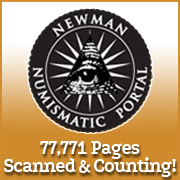
About UsThe Numismatic Bibliomania Society is a non-profit organization devoted to the study and enjoyment of numismatic literature. For more information please see our web site at coinbooks.org SubscriptionsThose wishing to become new E-Sylum subscribers (or wishing to Unsubscribe) can go to the following web page link MembershipThere is a membership application available on the web site Membership Application To join, print the application and return it with your check to the address printed on the application. Membership is only $20 to addresses in the U.S., $25 for First Class mail, and $30 elsewhere. For those without web access, write to: Terry White, Treasurer
AsylumFor Asylum mailing address changes and other membership questions, contact Terry at this email address: terrywhite5475@yahoo.com SubmissionsTo submit items for publication in The E-Sylum, just Reply to this message, or write to the Editor at this address: whomren@gmail.com BUY THE BOOK BEFORE THE COINSale Calendar |
- WAYNE'S WORDS: THE E-SYLUM JANUARY 3, 2016
- ASYLUM JULY-SEPTEMBER 2015 ISSUE PRINTING ERROR
- KOLBE & FANNING 2016 NY BOOK AUCTION REMINDER
- NEW BOOK: TRUTH SEEKER: THE LIFE OF ERIC P. NEWMAN
- NEW BOOK: EARLY RUSSIAN COINS AND THEIR VALUES, VOL 1
- DICK JOHNSON'S 2016 NEW YEAR'S RESOLUTION
- COLLECTORS DISCUSS NEWMAN NUMISMATIC PORTAL
- VIRGINIA ISSUED $1,000 BILL, NOT CONGRESS
- NOTES FROM E-SYLUM READERS: JANUARY 3, 2016
- THE NUMISMATIC AND ANTIQUARIAN SOCIETY OF PHILADELPHIA
- MARK TWAIN COIN WILL BE BOON FOR MUSEUMS
- MAURITIUS DAVID (1860-?)
- EVENTS AT THE 2016 NEW YORK INTERNATIONAL
- FRAUNCES TAVERN MUSEUM
- BEWARE POTENTIAL COUNTERFEIT CIVIL WAR TOKENS
- THE COUNTERFEITING OF U.S. GOLD COINS AFTER WWII
- 1804 SILVER DOLLAR SIGHTINGS
- THOUGHTS ON RARITY RATINGS
- HANDLING COINAGE IN SAN FRANCISCO IN 1885
- THE RISE AND FALL OF THE FRANKLIN MINT
- STUDY REVIEWS MEDAL OF FREEDOM AWARDEES
- FRENCH POLICE DOG TO RECEIVE DICKIN MEDAL
- SELECTIONS FROM STACKS BOWERS 2016 NYINC SALES
- MORE ON 'WHAT ARE TOKENS?'
- SMALL CHANGE USED MOSTLY BY ENSLAVED PEOPLES
- GOLD PLATES AND COINS UNEARTHED IN CHINA
- THE RARE NOTES OF LANAO PROVINCE, PHILIPPINES
- 1960 & 1963 GERMAN EMERGENCY BANK NOTES
- BANKNOTE PRINTER DE LA RUE SAYS CASH IS STILL KING
- CELEBRITY COLLECTOR: ACTOR MACKENZIE CROOK
- THE AUSTRIAN NATIONAL LIBRARY
- THE SOLOMON ISLANDS’ PIZZA COIN
- TEEN FIRST AGAIN AT ROYAL AUSTRALIAN MINT IN 2016
- NEW YEARS MEDALS
- FEATURED WEB SITE: CONDER TOKEN COLLECTOR'S CLUB
Click here to access the complete archive
To comment or submit articles, reply to whomren@gmail.com
WAYNE'S WORDS: THE E-SYLUM JANUARY 3, 2016

Happy New Year, everyone! We now have 1,912 subscribers.
This week we open with a reminder about the upcoming Kolbe & Fanning numismatic literature sale, a preview of the new biography of Eric P. Newman, and one other new book.
Other topics include the New York International, Fraunces Tavern Museum, the Newman Numismatic Portal, dealer Mauritius David, potentially counterfeit Civil War Tokens, rarity ratings, the Franklin Mint, the Medal of Freedom, the latest Dickin Medal canine honoree, and the first coin struck in 2016.
To learn more about Dick Johnson's Encyclopedia of Coin and Medal Technology, Swedish Private Bank Notes, phantom 1804 Silver Dollar sightings, handling gold coinage in San Francisco in 1885, General Numismatics Corporation, the rare notes of Lanao Province, Philippines, the grandson of Emperor Wu, and the Unpublished Transitional Hyperpyra of John III Vatatzes, read on. Have a great week, everyone!
Wayne Homren
Editor, The E-Sylum
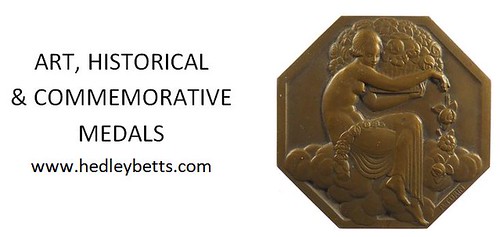
ASYLUM JULY-SEPTEMBER 2015 ISSUE PRINTING ERROR
Alan Luedeking writes:
 I recently received my latest copy of The Asylum (Vol. 33, No. 3, Jul-Sep 2015), and now possess what every collector of rare,
esoteric numismatic error literature can only dream about...not: An issue with a duplicated leaf, resulting in duplicated pages 75/76 and 85/86, and
missing the leaf with pages 73/74 and 87/88. I wonder, am I the only one or did they all get bound that way? Not being a particularly assiduous
collector of numismatic binding faux pas, I'd be happy to trade this pristine blundered copy for a normal copy, as I want to read the missing
pages.
I recently received my latest copy of The Asylum (Vol. 33, No. 3, Jul-Sep 2015), and now possess what every collector of rare,
esoteric numismatic error literature can only dream about...not: An issue with a duplicated leaf, resulting in duplicated pages 75/76 and 85/86, and
missing the leaf with pages 73/74 and 87/88. I wonder, am I the only one or did they all get bound that way? Not being a particularly assiduous
collector of numismatic binding faux pas, I'd be happy to trade this pristine blundered copy for a normal copy, as I want to read the missing
pages.
To read the earlier E-Sylum article, see:
ASYLUM JULY-SEPTEMBER 2015 ISSUE PUBLISHED
(www.coinbooks.org/esylum_v18n50a02.html)
KOLBE & FANNING 2016 NY BOOK AUCTION REMINDER
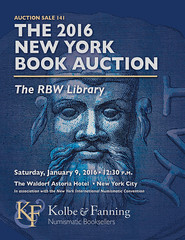 Kolbe & Fanning will be conducting our 2016 New York Book Auction this Saturday, January 9, at the Waldorf-Astoria Hotel in New York in
conjunction with the New York International Numismatic Convention. The sale features the celebrated RBW Library on Roman Republican coinage, as well
as other properties pertaining to ancient, foreign and American numismatics. Over 450 lots are included in the sale, which can be viewed through our
custom bidding platform at auction.numislit.com, where absentee bids can be placed in advance and where
bidders can participate in the sale live. The sale will begin at 12:30 p.m. eastern time, in the Norse Suite on the 18th Floor of the Waldorf-Astoria
Hotel. Lot viewing will take place in the Library Suite, also located on the 18th Floor, beginning on Thursday morning.
Kolbe & Fanning will be conducting our 2016 New York Book Auction this Saturday, January 9, at the Waldorf-Astoria Hotel in New York in
conjunction with the New York International Numismatic Convention. The sale features the celebrated RBW Library on Roman Republican coinage, as well
as other properties pertaining to ancient, foreign and American numismatics. Over 450 lots are included in the sale, which can be viewed through our
custom bidding platform at auction.numislit.com, where absentee bids can be placed in advance and where
bidders can participate in the sale live. The sale will begin at 12:30 p.m. eastern time, in the Norse Suite on the 18th Floor of the Waldorf-Astoria
Hotel. Lot viewing will take place in the Library Suite, also located on the 18th Floor, beginning on Thursday morning.
As a reminder, any absentee bids sent by fax or post must be received in Kolbe & Fanning’s Ohio offices by Monday, January 4. Bids may be placed with David Fanning by email to df@numislit.com or by phone at (614) 256-8915 through Friday, January 8. Phone and email bids cannot be accepted on the day of the sale. Those who wish to participate during the sale via the internet can do so through the online bidding platform at auction.numislit.com: bidders are strongly encouraged to register in advance to avoid any difficulties in last-minute registration. We are looking forward to the sale and thank you in advance for your participation.
For sale highlights, see this earlier E-Sylum article:
KOLBE & FANNING 2016 NEW YORK BOOK AUCTION HIGHLIGHTS
(www.coinbooks.org/esylum_v18n49a03.html)
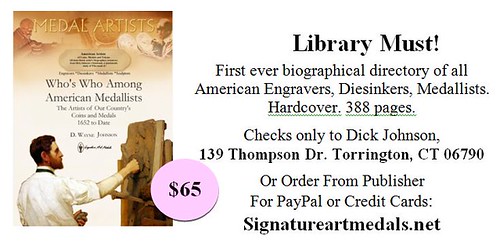
NEW BOOK: TRUTH SEEKER: THE LIFE OF ERIC P. NEWMAN
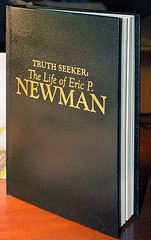 First, I want to assure our numismatic readers (and that should be nearly all of you), that the focus of this book is numismatics. While
the story of this centenarian's life is presented quite well, numismatics is the central focus of the tale. This should be evident in the choice
of authors - Len Augsburger, Roger Burdette and Joel Orosz are among the top numismatic researchers active today, and they are well versed in the
nuances of the American coin trade and its personalities and controversies of the last 100 years.
First, I want to assure our numismatic readers (and that should be nearly all of you), that the focus of this book is numismatics. While
the story of this centenarian's life is presented quite well, numismatics is the central focus of the tale. This should be evident in the choice
of authors - Len Augsburger, Roger Burdette and Joel Orosz are among the top numismatic researchers active today, and they are well versed in the
nuances of the American coin trade and its personalities and controversies of the last 100 years.
Newman's life has touched on and driven the story of several major numismatic events in this timespan, and all are addressed in this volume. Its title Truth Seeker is quite apt, for Newman's role in these events was as a tireless seeker and teller of numismatic truths, unfazed and undeterred by opponents who would rather paper over the facts for commercial or personal gain.
From the authors' Foreword:
Before we could dig into any of the documents, however, we exercised a privilege denied many biographers for our subject is still very much alive and in possession of an encyclopedic memory and quick wit. We sat with him around the table in the Newman family dining room, firing away our numismatic queries. Eric, age 102 at the time, seemed to draw energy from the cross-examination. In fact, each of our 13 sessions terminated only when his wife Evelyn would ask: “Are you boys just about done with your questions?”
Our blunt questions elicited unvarnished answers. Newman did not trim, did not equivocate. When it came to issues of right or wrong, ethical or unethical, there was only one word to describe his stance: uncompromising.
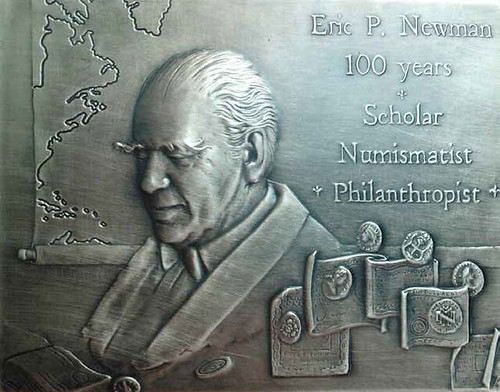
From the Introduction:
Eric Newman grew up in a world today’s collector can only experience through paper and ink and faded photographs. He came before the millions of children who pulled Lincoln cents out of their pockets and plugged them into cardboard cutouts. There was no Internet, no television, not even radio in his Missouri hometown. Nor was St. Louis a hub for would-be coin collectors.
The city might still have been the “gateway to the West” in the early 20th century but it had no coinage mint, and its Assay Office – which served miners returning from Western gold fields – closed in 1911, the year Eric was born. By age 11, his only connection to the outside numismatic world was a downtown coin store, St. Louis Stamp and Coin Co. Young Eric, on a 5-cents-a-week allowance, began to buy inexpensive coins from Burdette Johnson, the store’s proprietor. Johnson’s role in Eric’s life as mentor, friend and eventually business partner would change both their lives.
Newman went on to get a business and engineering degree from MIT and a law degree from Washington University in St. Louis, to begin a career as a lawyer and business executive, to marry his sweetheart, Evelyn Frances Edison, and start a family.
Then there is Eric Newman as numismatic researcher and author. For years, research took priority over the convention scene for Newman. If he was going to get on a plane for numismatic purposes, he was more likely to be visiting a library than attending a coin show. “We didn’t have everything on microfilm in the early days, we didn’t have everything on computer,” he recalled. “We had to go from library to library and read every bit of it and make notes and try to piece together all the wonderful information that was out there.”
Newman’s first such article appeared in 1941, on the subject of an early St. Louis bank note, and was published by the Missouri Historical Society.
Part I covers Newman's early years in five short chapters, and Part II covers his family, wife Evelyn, and their globe-trotting family. But numismatics is a theme throughout, including the coin necklace worn by Evelyn when they first met.
Those 59 pages are just a warmup for the wild numismatic ride to follow. Remaining parts of the 418-page book cover Eric's acquisition of much of the Col. E.H.R. Green collection, his relationship with Burdette Johnson and numismatic scholars Wayte Raymond, F.C.C. Boyd, John J. Ford, Jr., Q. David Bowers, George Fuld and Don Taxay.
Extensive sections cover The Fantastic 1804 Dollar, the 1853 $20 U.S. Assay Office of Gold controversy, the Lilly Collection and counterfeit western bars, and the pursuit of Clapp Large cents switched out of the American Numismatic Society collection.
Along the way of course, the book covers Eric's research and publication of several landmark books including The Early Paper Money of America, and multiple important papers and monographs including those authored in his 2nd century.
Above is an image of one of the hardbound advance copies. The regular edition is not yet available for purchase. Stay tuned for more information. I'm still working my way through it, but am already convinced this is the one book an American numismatist must have in their library to understand the full sweep of numismatic research and commerce in the 20th century and beyond.
Hats off to Eric, and kudos to the author team for pulling these multiple important stories together in one handy volume. But even a large, well-researched book such as this cannot encompass all the facts and details; it provides the framework on which future research of the era will rest, opening new questions for 21st century truth-seekers to pursue. They will be standing on the shoulders of a numismatic giant, Eric P. Newman.
To read the earlier E-Sylum article, see:
NEW BOOK: TRUTH SEEKER: THE LIFE OF ERIC P. NEWMAN
(www.coinbooks.org/esylum_v18n50a06.html)
NEW BOOK: EARLY RUSSIAN COINS AND THEIR VALUES, VOL 1
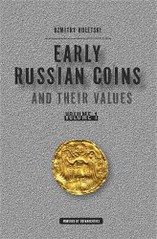 This book is a first volume of the series of price guides, which presents the main types of early Russian coins. Coin values are listed
along with the results of some auction sales collected by means of the Coinarchives service. In order to learn medieval Russian coins thoroughly, we
recommend our standard catalogue “Early Russian Coins 1353–1533” by Huletski, Petrunin and Fishman, printed in Charlestown in 2015.
This book is a first volume of the series of price guides, which presents the main types of early Russian coins. Coin values are listed
along with the results of some auction sales collected by means of the Coinarchives service. In order to learn medieval Russian coins thoroughly, we
recommend our standard catalogue “Early Russian Coins 1353–1533” by Huletski, Petrunin and Fishman, printed in Charlestown in 2015.
English language.
56 colour pages.
Issue limit - 1000 pcs.
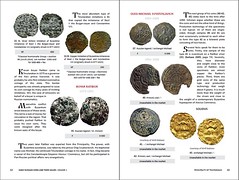
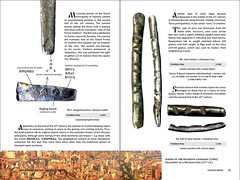
For more information, or to order, see:
http://wirecoins.de/erc1/
THE BOOK BAZARRE
DICK JOHNSON'S 2016 NEW YEAR'S RESOLUTION
In 2016 I want to publish my Encyclopedia of Coin and Medal Technology. I must obtain 1200 illustrations to go with the 988 pages of text I have written.
I began collecting the terms and tasks of medal making 50 years ago when I first went to work for Medallic Art Company. I recognize I was like so many of my collector friends, ignorant of the process of creating coins and medals. This information was not easily available, no book on the subject revealed what I wanted to learn.
So I started to write down the terms workers at MACO used. If the meaning wasn't obvious I would ask what it meant, sometimes even asking to show or tell me the process. Maybe I was a little obnoxious at times but fellow workers from the vice president on down were patient with me, so I learned fast.
I became fascinated with these terms and my list grew. I had several hundred by the time I left MACO and became a medal dealer. That is when my list exploded, particularly since I had to describe these numismatic items in my auction catalogs. Perhaps I had reached a thousand terms by the time I stopped cataloging and "retired."
In my retirement I began writing the definition and description of each of those terms until they were encyclopedic in length. I added the other 250 terms along the way.
I did not want to write a textbook, or a "how to" book with all this text. Instead I wanted a reference book, a book that would be on the desk of everyone in the field -- from designer, to modeller or engraver, to manufacturer, to collector, to curator -- to cover the entire field. For maximum use by everyone.
That's a big chore I know, but it's a new year. I've set a big goal.
COLLECTORS DISCUSS NEWMAN NUMISMATIC PORTAL
"Boosibri" wrote:
With some time off over the holidays I continued my search for the provenance of my 1842 $5 ex. Milas. I checked back through Archive.org, a great site in searching public records, libraries and universities for amazing historical documents.
I frequent this site and recently a set of very important auction catalogs have been uploaded. The catalogs in normal form are important but what makes these especially important is that they are annotated with the buyers of the lots. Cleneay, Parmalee two name two. Many of these come from the Harry Bass Library via Dan Hamelberg. These documents allow for provenances to be researched with potentially one of a kind reference documents available to all.
Len Augsburger clarified the relationship between Archive.org and the Newman Numismatic Portal. He wrote:
The Newman Portal uses Internet Archive as a scanning repository. All scans appear at Internet Archive. Material scanned by the Newman Portal appears on Internet Archive almost immediately, so the latest activity can always be seen there. In parallel, the Newman Portal has its own website that presents a cleaner interface to scanned materials. That link is Newman Numismatic Portal. This site will lag behind the activity on Internet Archive. In particular, we currently have a large number of auction catalogs on Internet Archive that are not yet linked into the Portal.
We are systematically working through the early U.S. auction catalogs in the rare book room at the American Numismatic Society. We have 90 of these already posted on Internet Archive, with a good number in the Chapman and Cogan series. We've also had material loaned from private libraries - Dan Hamelberg, Bill Burd, and others. Our intention is to maintain a good mix in the scanning pipeline - auction catalogs, periodicals, books, and archival material from the Newman library. All that said, we are certainly open to requests and will fit these in as our bandwidth allows.
"Sonorandesertra.." wrote:
This will be a humdinger of a resource for collectors interested in pedigrees and numismatic history in general.
"Boosibri" added:
I have begun tracing back the Clapp/Eliasberg half eagles through the material to Cleneay, Earle, Parmalee, etc.
To read the complete discussion thread, see:
Topic Title: Newman Numismatic Portal
(https://forums.collectors.com/messageview.aspx?catid=26&threadid=956750&enterthread=y)

VIRGINIA ISSUED $1,000 BILL, NOT CONGRESS
Regarding the Marketplace.org article quoted in last week's issue, Ron Thompson writes:
I have been collecting obsolete currency, including Continental Currency, for a while. I have a number of the references. So I was surprised to read in the article “ The Continental Congress – a body of delegates representing the thirteen colonies – began issuing paper money, which included the $1,000 bill, to help finance the revolutionary War,…” Really, news to me.
Eyeballing the Friedbergs’ Paper Money of the United States and Newman’s The Early Paper Money of America doesn’t reveal any $1,000 bills issued by the Continental Congress. In fact the highest denomination I find is $80 authorized January 14, 1779. Perhaps the author was referring to what we call today checks or drafts rather than actual bills or notes? Perhaps he was referring to some colonies that did issue notes greater than $100, including Virginia, which issued notes for $1,000, $1,200, $1,500, and $2,000. Am I missing something??
Jim Wells writes:
 Under the "history" subtitle is pictured a colonial $1000 bill described as issued by the Continental Congress to finance the
Revolutionary War. But the bill pictured is not Continental Currency, whose largest bill was $80. The 1781 $1000 bill pictured is clearly from the
Assembly of the state (Commonwealth) of Virginia, as shown in the bottom border that reads VIRGINIA CURRENCY. Two months later Virginia also issued
bills for $1200, $1500, and $2000.
Under the "history" subtitle is pictured a colonial $1000 bill described as issued by the Continental Congress to finance the
Revolutionary War. But the bill pictured is not Continental Currency, whose largest bill was $80. The 1781 $1000 bill pictured is clearly from the
Assembly of the state (Commonwealth) of Virginia, as shown in the bottom border that reads VIRGINIA CURRENCY. Two months later Virginia also issued
bills for $1200, $1500, and $2000.
Ron Ward writes:
The $1,000 Colonial note shown in the scan was issued in Virginia by an act of the Virginia Legislature in 1781 (see Newman, 2008, page 455), not by the Continental Congress The highest denomination note from the Continental Congress was for $80.00 (Newman, page 73). Evidently the curator at the ANS was not very familiar with Colonial currency.
To read the earlier E-Sylum article, see:
WHY DO WE NO LONGER USE $1,000 BILLS
(www.coinbooks.org/esylum_v18n52a28.html)
NOTES FROM E-SYLUM READERS: JANUARY 3, 2016
On Einstein and God
Mel Wacks writes:
I was delighted to read Dr. Kavan Ratnatunga's comments about the Einstein counterstamped half dollars. I never thought of the visual relationship between Einstein and the IN GOD WE TRUST motto. It is most appropriate since there are many quotes of Einstein about God--like "God does not play dice with the universe."
To read the earlier E-Sylum article, see:
NOTES FROM E-SYLUM READERS: DECEMBER 27, 2015 : In Einstein We Trust
(www.coinbooks.org/esylum_v18n52a11.html)
Electronic Version of Mickley's 1858 Monograph Sought
Craig Sholley writes:
I'm wondering if anyone out there has a .pdf of Joseph Mickley's 1858 Dates of US Coins and Their Degrees of Rarity. It's very notable as the first public mention of Judd 58.
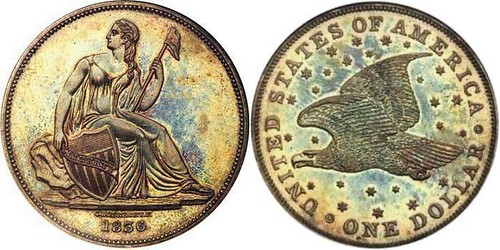

The Mickley pamphlet hasn't yet been digitized by the Newman Numismatic Portal. Does anyone have a scan of it? -Editor
Named Cogan Clemens Sale Sought
Saul Teichman writes:
Does anyone have a named Cogan 10/22/1878 Clemens sale ? I'm trying to find out who purchased the 1838 Gobrecht dollar which was originally Mickley’s. Any help E-sylumites can provide be would be greatly appreciated.
Numismatic News Subscription End Dates
Bob Fritsch writes:
While catching up records at year’s end, I noted a discrepancy in the expiration dates of my Numismatic News subscriptions. The previous one expired December 2015, while the new one expires in August 2015. The reply to my Customer Service query said that NN does 32 issues per year which is August. Not satisfied with the answer, I addressed the problem to Dave Harper and the matter was resolved the same day. Seems the subscription department forgot that the 32 paper issues were interspersed with 20 digital issues. My yearly subscription now expires in December as it should.
Every subscriber to NN should be aware of this problem as I doubt my subscription is the only one affected. A global fix should be in the works but everyone should keep an eye on their subscriptions to determine if the problem affects them and that it gets fixed within the next month or so. Thanks Dave for a quick resolution to the problem.

THE NUMISMATIC AND ANTIQUARIAN SOCIETY OF PHILADELPHIA
Dave Hirt writes:
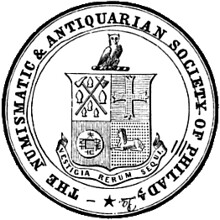 The post on the Philadelphia Numismatic and Antiquarian Society was of interest to me. I have had an interest in them for a long time. I
have a complete set (I think) of their proceedings from 1856-1946. As was mentioned, many famous numismatists belonged, especially in the early days.
As the years went by they seemed to become more and more antiquarian and less and less numismatic. After the 1950's I did not see anything about
them published in The Numismatist. I didn't think that they still existed.
The post on the Philadelphia Numismatic and Antiquarian Society was of interest to me. I have had an interest in them for a long time. I
have a complete set (I think) of their proceedings from 1856-1946. As was mentioned, many famous numismatists belonged, especially in the early days.
As the years went by they seemed to become more and more antiquarian and less and less numismatic. After the 1950's I did not see anything about
them published in The Numismatist. I didn't think that they still existed.
Then, in the August 2012 issue of The Numismatist there was a letter to the editor from a Richard DiStepano, an ANA member, stating that the society was alive and well, and holding 3-4 meetings a year. That was quite a surprise to me. However, since that time I have not seen anything about them.
I wish a Happy New Year to all!
To read the earlier E-Sylum article, see:
NUMISMATIC AND ANTIQUARIAN SOCIETY OF PHILADELPHIA ARCHIVES
(www.coinbooks.org/esylum_v18n52a13.html)
MARK TWAIN COIN WILL BE BOON FOR MUSEUMS
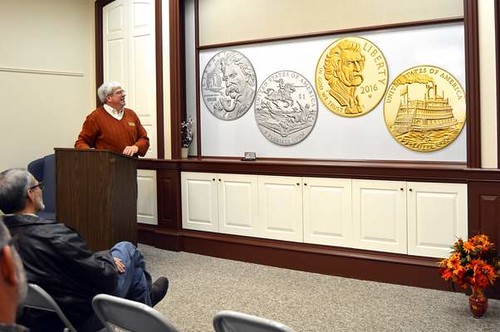
Henry Sweets, executive director of the Mark Twain Boyhood Home & Museum
Mark Twain once quipped, “The lack of money is the root of all evil.”
But starting early next year, some of Twain’s favorite places — his Missouri hometown, the New England community where he spent a big part of his adult life and two universities — all stand to benefit from the U.S. Mint’s gold and silver coins honoring the author and humorist.
Up to 100,000 gold coins and 350,000 silver coins bearing Twain’s mug will be available throughout 2016 or until they are sold out, U.S. Mint spokesman Mike White said.
Each year, the mint strikes two commemorative coins to benefit nonprofit organizations. As collectables, the coins are worth far more than their $1 face value for silver and $5 for gold. For example, 2015 commemorative silver coins recently were priced at about $52, gold for about $360.
Each carries a surcharge — $35 for gold, $10 for silver — to be divided evenly among the Mark Twain House & Museum in Hartford, Connecticut; University of California, Berkeley, for a program to study and promote the legacy of Twain; Elmira College in Elmira, New York; and the Mark Twain Boyhood Home & Museum in Hannibal, Missouri.
It’s a potentially big windfall.
“If the entire issue is sold, it could be well in excess of $1 million for each of the sites,” said Henry Sweets, executive director of the Hannibal museum, which has an annual budget (including its properties) of about $850,000.
Collectors generally account for about three-quarters of commemorative coin sales, but Sweets said, “With the topic of Mark Twain, I think we’ll have a lot of people who are interested.”
Twain was born Samuel Clemens in Florida, Missouri, on Nov. 30, 1835. His family moved to Hannibal a few years later.
It was in Hannibal where he grew up, fell in love with the Mississippi River and made the friends and acquaintances that provided fodder for some his most famous works — “The Adventures of Tom Sawyer,” “The Adventures of Huck Finn” and “Life on the Mississippi” among them.
Twain left Hannibal when he was 17. He lived in Hartford from 1874 to 1891.
To read the complete article, see:
Mark Twain coin will be boon
for museums honoring him (www.nhregister.com/lifestyle/20151225/mark-twain-coin-will-be-boon-for-museums-honoring-him)
MAURITIUS DAVID (1860-?)
David, Mauritius (1860-?), his first name Mauritius is Latin for the English Morris or "Moe", and he is known to have sometimes used the French Maurice and the German Moritz. He was a coin and medals dealer since at least January 1898. The Gnecchi brothers supplied the year of his birth as 1860, which, as all information they supply should be checked since there were many errors in their text.
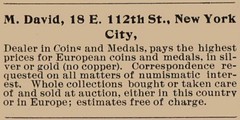 Mr. David ran advertisements in The Numismatist from January through April, 1898 in a campaign to establish himself as an
international dealer and buyer. His display advertisements published with the others in the back matter of The Numismatist sought European
silver and gold coins and medals with the exception of copper. "Whole collections bought or taken care of and sold at auction, either in this
country or in Europe". Obviously he had enough funds to advertise purchasing entire collections, which is most probably how he acquired the $5
gold pieces he sold to Virgil Brand a little more than a year later.
Mr. David ran advertisements in The Numismatist from January through April, 1898 in a campaign to establish himself as an
international dealer and buyer. His display advertisements published with the others in the back matter of The Numismatist sought European
silver and gold coins and medals with the exception of copper. "Whole collections bought or taken care of and sold at auction, either in this
country or in Europe". Obviously he had enough funds to advertise purchasing entire collections, which is most probably how he acquired the $5
gold pieces he sold to Virgil Brand a little more than a year later.
He seems to have moved annually at the end of a year's lease beginning in 1897 on giving the impression he is fleeing from landlord to landlord.
The earliest known correspondence with the Chapman brothers is dated August 8, 1898, eleven months after M. David's first appearance in The Numismatist. It is probable that earlier correspondence or at least some record of it may exist in the ANS Museum or in some other numismatic collection.
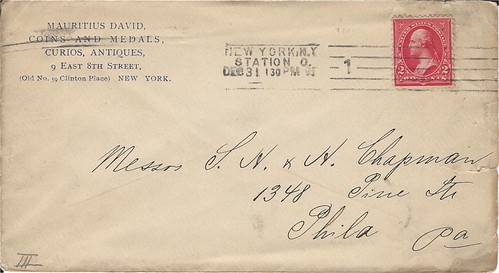
In August 1899 he applied for membership in the A.N.A. and is member No. 109. In August and December 1899, he placed orders for catalogues and coins, including a priced catalogue of the Chapman brothers auction held on December 22, and a new U. S. cent for 1900. Also in August 1899, on the 14th, Dave Bowers tells us that he sold Virgil Michael Brand high end $5 gold rarities including an 1815 for $200, an 1822 for $800, 1824 and 1826 for $60 each.
He was a donor to the ANS collection and Library from 1899-1901.
Sometime between April and October 1900, he published the English translation of the exhibition catalogue of European coins and medals in April 1900 at Frankfurt by Ferdinand Luthmer (1842-1921), director of the Kunstgewerbemuseums, under the title , The International exhibition of medals in the Kunstgewerbe-Museum in Frankfurt o. M., April 1900. A notice of this was published by George Heath in The Numismatist, Volume XIII, No. 11, November (1899) : 305, after receiving a gift copy for the public announcement.
To read the complete article, see:
DAVID,
MAURITIUS (https://sites.google.com/site/numismaticmallcom/encyclopedic-dictionary-of-numismatic-biographies/david-mauritius)
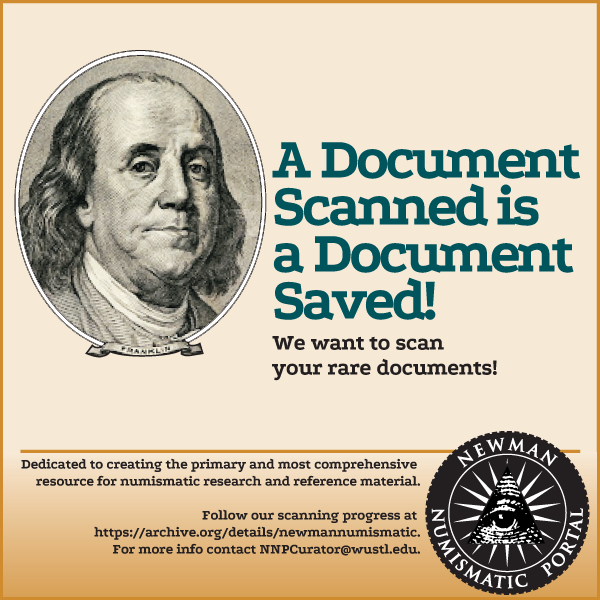
EVENTS AT THE 2016 NEW YORK INTERNATIONAL

Peter Preston-Morley of Dix Noonan Web writes:
Seeing Skyler Liechty’s very welcome announcement that Dave Bowers will address the MCA meeting at NYINC on January 9th reminds me that I should have advised you before now of the British Numismatic Society meeting on the same day!
The London-based BNS was founded in 1903 and this will be our first ever meeting held outside the UK. Our aim is that it will become an annual gathering at the NYINC and lead to further contact and involvement with our growing North American membership.
The meeting will be in the Beekman Suite at the Waldorf-Astoria on January 9th at 4 PM. The chair will be occupied by Ken Eckardt, a renowned specialist in West Indies cut and countermarked coins, and the speaker will be Peter Preston-Morley, the subject matter ‘The Transition from Hammered to Milled Coinage in the British Isles’. Besides being the secretary of the BNS, the speaker has been a regular at NYINC since the Dick Margolis-organised shows of fond memory.
All those who are visiting the show and interested in British coins are very welcome to attend and there will be an opportunity to win a year’s free Society membership!
In addition to the blockbuster auctions by Classical Numismatics Group, Heritage, Stack's Bowers-Ponterio and Baldwin's, and the major numismatic literature sale by Kolbe-Fanning, there are a number of organization meetings and presentations taking place. Here are the events for Saturday, January 9, 2016. -Editor
10am: Meeting: Ancient Coin Collectors Guild
Program: Peter Tompa
Cultural Property Update
Lexington Suite
11am: Meeting: Association of Dedicated Byzantine Collectors
Program: Don Squires
Unpublished Transitional Hyperpyra of John III Vatatzes
Beekman Suite
NOON: Meeting: Medal Collectors of America
Program: Q. David Bowers
The Lure and Lore of American Medals
Lexington Suite
1pm: Program: Sponsored by the New York Numismatic Club
Mark Anderson
Swedish Private Bank Notes: Economic Context and Historical Sensibilities
Beekman Suite
3PM: Meeting: Sponsored by the New York International Numismatic Convention
Jyrki Muona
The Imperial and Provincial Coin Age of Otho
Lexington Suite
4pm: Meeting: British Numismatic Society
Program: Peter Preston-Morley
The Transition from Hammered to Milled Coinage in the British Isles
Beekman Suite
5pm: Meeting: Oriental Numismatic Society
Program: Roundtable Discussion and questions on all aspects of Oriental numismatics
Lexington Suite
7:30pm: Meeting: Bermanian Guild of Numismatics
Hosted by Their Royal Majestic Alanus I Rex Bermaniae and Barbara Regina
Program: His Royal Majestic Alanus I
Topic to be Announced
Beekman Suite
To read the complete list of 2016 NYINC events, see:
www.nyinc.info/events.php
To read the earlier E-Sylum article, see:
NOTES FROM E-SYLUM READERS: DECEMBER 27, 2015 : MCA Meeting at 2016 NYINC
(www.coinbooks.org/esylum_v18n52a11.html)
FRAUNCES TAVERN MUSEUM
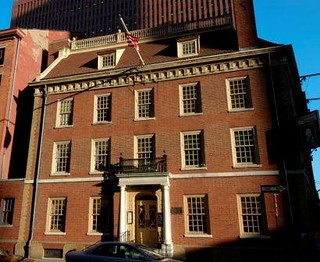 Those attending the New York International Numismatic Convention this coming week might find Fraunces Tavern Museum in Lower Manhattan a
pleasant and related diversion. The tavern, purchased by Samuel Fraunces in 1762 and originally known as “The Queen’s Head,” was the site of many
historic events.
Those attending the New York International Numismatic Convention this coming week might find Fraunces Tavern Museum in Lower Manhattan a
pleasant and related diversion. The tavern, purchased by Samuel Fraunces in 1762 and originally known as “The Queen’s Head,” was the site of many
historic events.
In addition to being a popular public gathering spot in the revolutionary era, it was a meeting place of the Sons of Liberty and, notably, where General George Washington bade an emotional farewell to his officers on December 4, 1783 after independence was won.
In this building, the early national government operated its departments of foreign affairs, treasury and war. Other organizations, including the New York Chamber of Commerce, Tammany Society and the New York Yacht Club were launched there.
In addition to being an excellent restaurant with some colonial fare, the five-building complex houses a delightful museum. History buffs will be impressed by the Washingtoniana. There are rooms devoted to Washington lithographs, period and later artifacts, and early American flags. The Long Room, where the famous farewell took place, is recreated. There is a room of eighteen paintings of Washington and the Revolutionary period by John Ward Dunsmore.
Although not a numismatic museum, a few 19th century medals commemorating Washington are exhibited. There are three medals honoring Frederick Samuel Tallmadge, who was instrumental in obtaining the building for the Sons of the Revolution in 1904 and a descendent of one of those at the 1783 dinner. There also are a number of badges displayed.
Fraunces Tavern and Museum are surrounded by other historic sites, including Federal Hall, where Washington was inaugurated in 1789, and the South Street Seaport. Walking the neighborhood presents an opportunity to see the seaport area later immortalized by painter John Stobart, such as at Maiden Lane. A ten-minute walk brings you to 241 Water Street, where the trading concern of Talbot, Allum & Lee was located; the company, of course, issued the 1794 and 1795 tokens. The address is now the site of the independent Blue School.
For more information on Fraunces Tavern Museum, see:
http://frauncestavernmuseum.org/

BEWARE POTENTIAL COUNTERFEIT CIVIL WAR TOKENS
eBay is many things to collectors. Overall, it is a positive thing. For exonumia collectors, eBay has been a great resource in that much more is available. Let's face it, the majority of coin dealers don't handle much exonumia, so coin shops and coin shows are not a great source for exonumia collectors. eBay has certainly given exonumia collectors a great resource for obtaining material for their collections.
On the other hand, eBay has also been a great resource for sellers that may not be as reputable as your local coin dealer. There are some very good sellers on eBay (I can think of three Civil War token dealers off the top of my head); however, there are also many shady characters out there. Anyone who has dealt with eBay for very long is well aware that eBay doesn't go out of its way to police unscrupulous activity. There are mechanisms to report improper behavior or questionable listings, but it has been my experience that eBay does nothing with the report.
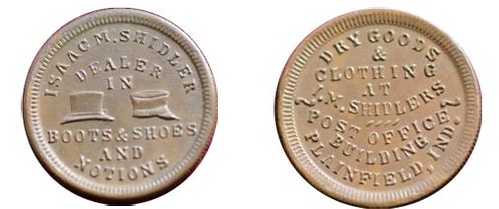
Another “Civil War token” has been showing up with some regularity of late. IN-770C-1a is a very popular token due to its depiction of two hats from the Civil War era. Three examples of this rarity 6 token have appeared this summer, two from a seller from the Czech Republic and another from Greece.
They all may be the real deal, but what are all these IN-770C-1s doing in Europe? Also, why are they all showing up all of a sudden? Will we be seeing more of these coming out of Europe? I would be interested in hearing from any reader who may have purchased one of these. I recently "won" one of these auctions so I could closely examine it. As of the time of this writing, it has yet to arrive from the Czech Republic. If it isn't an obvious fake, I may send it to NGC for verification.
A seller from Cyprus recently sold about a dozen purported CWTs. Most were fairly common tokens and looked like they might be okay, but had odd coloration. However, they were sold at the same time by the same seller as these two obvious fakes:
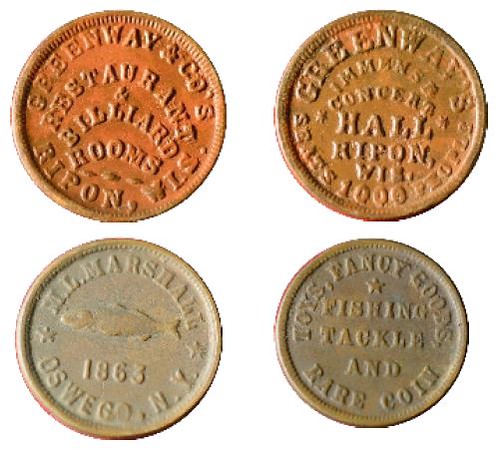
If you look closely, you will see that both of these "tokens" exhibit bubbles (probably because they were cast and not struck). They both also show very "mushy" lettering throughout and the Ripon piece shows odd coloration as well. If a [reader] won either of these lots, I would be interested in hearing from you. I suspect there is a line on the rim, perhaps filed down, that would be further evidence that these were cast.
I reported these obvious fakes to eBay which did nothing of course. My point is that you can't rely on eBay to ensure the accuracy of a listing or to ensure the items for sale on eBay are authentic. Sure they have a policy against selling fakes, but eBay has demonstrated over the years that it isn't exactly interested in enforcing it.
The point to be made here is that while there are some very good eBay sellers, there are also unethical sellers on eBay. Don't expect eBay to save you from a bad experience. Do business with reputable sellers and you may want to consider submitting your tokens to a third party grading service. Arm yourself through education and a healthy dose of skepticism and be careful out there!
Larry Dziubek writes:
Fake (cast) tokens are coming from eastern Europe and Greece. NGC certified several that we submitted as bad. We think the same guy is now auctioning fakes from Bulgaria. Incidentally, the previous sellers shipped from Bulgaria so it is possible that this is all the same individual. He also sold better date Indian Head cents. I believe he sold fake European badges and medals in earlier eBay sales. The seller gives quick refunds to those who report dissatisfaction so as NOT to get bad Feedback. Through the strong efforts of the Civil War Token Society officers who complained to eBay , over fifty phony looking tokens disappeared from his recent offerings.
Paul Cunningham writes:
When one party (eBay) is shown beyond a reasonable doubt that a person (the faker) is selling trash as "gold," does that make the one party committing collusion with the other? Isn't that illegal most everywhere?
Patriotics:
Liberty head (5)/God Protect the Union (288)
Army and Navy/The Federal Union (won't hazard a guess at attributing)
Army George Washington (108)/Our Union (201)
Army Capitol (233)/Army & Navy (312)
Army Horrors of War (256)/Union For Ever (433)
Storecards:
MI-225K-3a (Broeg & Gerber, Detroit)
MI-225M-3a (Busch, Detroit)
MI-225AFa-7a (Gies, Detroit)
MI-225AM-2a (Hilterscheid, Detroit)
MI-225CC-3a (Sutherland, Detroit)
NJ-885A-2b (Titus, Trenton)
NY-695A-2a (Marshall, Oswego)
OH-115B-5a (Squier, Cambridge)
OH-165T-5a (Campbell, Cincinnati)
OH-165BD-3a (Gentsch, Cincinati)
OH-165FC-2a (Sacksteder, Cincinnati)
OH-165FZ-3a (Sutton, Cincinnati)
For more information about the Civil War Token Society, see:
www.cwtsociety.com
THE COUNTERFEITING OF U.S. GOLD COINS AFTER WWII
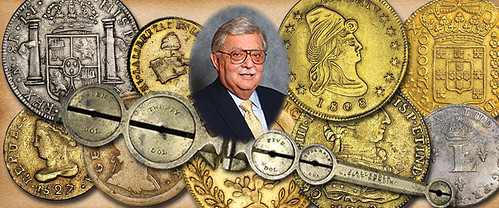
Counterfeiting happened all over the world after the Second World War. Gold coins were collected here in the United States, even after the Gold Acts of 1933 and 1934 called in gold coins in this country. However, collectible gold coins were exempt from confiscation by federal authorities. So to gather a "store of wealth," of gold, many became collectors. Since the supply was small here in the United States people looked elsewhere in the world for gold coins. Many were found in overseas vaults, and collections, where restrictions on ownership were not in place or were not enforced. But as the demand grew in the United States, the value of many of these gold coins went up along with the demand. Thus, it became worthwhile for counterfeiters to make false coins, which looked like federal issues but were not made in an official mint. Some of these counterfeits were easily recognized by enforcement agents -- in the United States the Secret Service. Others were more skillfully made and were even deceptive to federal agents. And as the prices of collectible gold coins went up, the public was being 'ripped off" while the counterfeiters were making even more money.
Let me mention two denominations that were flooding the country. One was the gold dollar, struck from 1849 to 1854. It was a small coin with a nice design, easily recognized by enthusiasts, including by families from Caribbean countries. They loved these gold dollars and gave them as gifts, often to newlyweds for luck -- each gift was customarily 13 coins. Assembling groups of 13 at a time put a strain on the supply and the price of the coins rose from face value to as much as 20 to 30 times that amount. The small size made the coins easy to counterfeit. Money could be made by recreating the coins in gold, and selling them at many times the intrinsic value! As the practice continued, lower-carat gold was used, making the deception even more lucrative.
The same deception occurred with Liberty Head $2.50 coins, struck by United States mints from 1840 to 1907. These were the favorites of many people who came to the United States, especially from Asia. In the West, when railroads were being built, many thousands of people came to America for jobs, and worked here as we built our way across the country. The gold quarter eagle design and size became familiar (as it was the only one that might be recognized from circulation) and popular to accumulate.
This tradition continued for many, many years, and was evident in America even into the late 1970s. When the price of gold went up, the coins became more desired and harder to acquire. As with the gold dollars, counterfeiters used this as an opportunity to make large profits by fabricating these quarter eagles.
Similar situations of rising value and increased scarcity for different gold coins encouraged the manufacture of counterfeits, not only for United States coins, but also for other scarce coins struck throughout the entire world.
So these are examples of what the situation was after the Second World War and what brought about the flood of counterfeits and the attempts by the Government to prevent these false coins from entering the country and fooling American citizens. In upcoming articles, I will offer some personal recollections of how this counterfeiting and the government’s attempts to control it affected Stack’s Rare Coins.
To read the complete article, see:
Counterfeiting
and its Effects on Numismatics, Part Two (www.stacksbowers.com/NewsMedia/Blogs/TabId/780/ArtMID/
2678/ArticleID/65517/Counterfeiting-and-its-Effects-on-Numismatics.aspx)

1804 SILVER DOLLAR SIGHTINGS
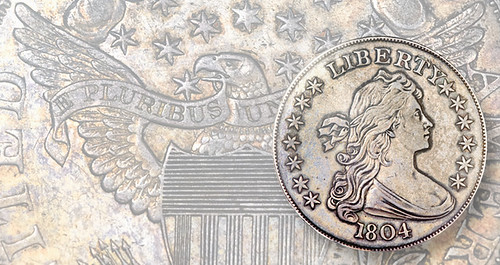
Those 1804 silver dollars keep turning up all over the place.
While U.S. Mint records show 19,570 Draped Bust dollars were struck in 1804, only 15 coins are known with that date, all struck decades later either for friends of Mint officials or foreign diplomats.
The 19,570 dollars listed in Mint records, if they were actually minted in 1804, were likely struck with 1803-dated dies.
Additional finds of “genuine” 1804 dollars continue to be reported, though. Here are a few of the more amusing ones.
➤ Aug. 1, 1895, Hartford (Conn.) Weekly Times: Tramp Charles Schultz steals an 1804 dollar from Felix Schultz, who befriended him, and sells it to Scott Stamp and Coin Co. for $90. Scott Co. says it doesn’t know anything about it.
➤ Dec. 25, 1897, The Reading (Pa.) Eagle: Chateau, Mont., bartender Billy Seymour receives one in change. The paper reports, “Whence the dollar came, Mr. Seymour does not know, but each one of several enthusiastic fellow-townsmen is willing to swear that it belonged to him and was passed by mistake as he well knew that it was valuable. ...”
➤ Oct. 25, 1899, Lewiston (Maine) Evening Journal: A Racine, Wis., woman pays for fabric or thread with a well-worn 1804 dollar that the clerk pockets, replacing it with another dollar from his own pocket. “We are told,” the paper reports, “he has since been offered $1,500 for it by a Chicago coin dealer.” The storeowner, in the meantime, maintained the coin was his and not the clerk’s and hired a lawyer.
➤ June 21, 1912, The (Pittsburgh) Gazette Times: “A worn silver dollar dated 1804, which Joseph Ralston of Defiance, O., bought from $50 from a tramp nearly a score of years ago, may give Mrs. Ralston, his widow, comfort in her declining years.”
“Treasury officials, who tested the coin ... said they believe it was a genuine 1804 dollar, appraised by coin collectors at $2,800.”
➤ Jan. 1, 1914, Meriden (Conn.) Weekly Republican: Laborer William Sullivan, excavating a site for an ice rink for the Yale hockey team “turned over with his shovel an old jar.” Also in the jar, reportedly, was an 1804 silver dollar “understood to be quoted at $3,500.”
➤ April 5, 1924, Gridley (Calif.) Herald Twice-A-Week: Merchant Martin Hettinger of Lancaster, Ohio, says he received an 1804 silver dollar from Col. William Stevenson, who asked that he not dispose of it. The coin is reportedly valued at $8,000 to $12,000.
So keep your eyes open when you check your change, take in a tramp or get a gift from a relative — you, too, just might find an 1804 silver dollar.
To read the complete article, see:
Unlikely stories of finds of
'1804 Draped Bust dollars': Coin Lore
(www.coinworld.com/news/us-coins/2015/12/searching-for-an-1804-draped-bust-dollar.all.html)
THOUGHTS ON RARITY RATINGS
I’ve recently looking at some rarity ratings and I wonder if E-Sylum readers would like to express an opinion or two (or twenty :-) ). The question at hand is fairly simple:
If you see an item described in a reference work or auction catalog as R-7, what does that mean to you?
There are a number of rarity scales. For the sake of discussion, let’s assume that you know for sure that the R-7 rating was intended to be relative to the following scale, which I think is the scale most commonly used in a number of areas, at least when it comes to exonumia:
R-1: 5,000+
R-2: 2,001-5000
R-3: 501-2000
R-4: 201-500
R-5: 76-200
R-6: 21-75
R-7: 11-20
R-8: 5-10
R-9: 2-4
R-10: 1 (unique)
Here are some possible answers for what “R-7” might mean:
- The writer knows for sure that 11-20 currently exist, period.
- The writer knows for sure that 11-20 existed at some point (the original mintage was 11-20).
- 11-20 unique specimens have been sold in the last X years.
- If you wait X years, you’ll probably have 11-20 opportunities to buy one.
- 11-20 unique specimens have been sold, ever (say, since 1850).
- A bunch of specimens are known to have been sold, but if you discount the ones that are definitely locked up in museums, there are 11-20 available to collectors.
- The writer found 11-20 pieces in survey of major collectors of the series.
- There are 11-20 nice examples available. There might be more, but all the rest are cruddy.
- The total population by the third-party grading services is 11-20.
- The writer found 5-10 auction appearances and assumes that they missed a few (or that there are some that have never been publicly sold).
- The original mintage was 30-50 and the writer assumes that some have been lost/melted/otherwise permanently gone.
- The writer thinks that this is rarer than pieces described as R-6, but doesn’t really intend to say anything about specific numbers.
- The original mintage was 50, but one guy has a hoard of 30 of them so those don’t really count.
- The writer doesn’t really know how many exist, but this costs the same as other items listed as R-7
- The writer just quoted a number from some other reference and doesn’t really have any opinion of their own.
- The writer just pulled a number out of thin air that doesn’t mean anything, and you should judge the item on its merits for yourself.
- etc
- etc
- etc
- (feel free to add your own)
If you want to look at the question from the other direction, what rarity would you expect to see for each of the following examples? FWIW, each of these are real examples of items that I found described as R-7. I picked items where the original mintage is known. The question gets a lot harder otherwise!:
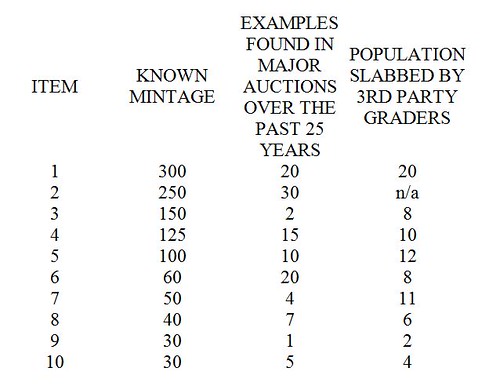
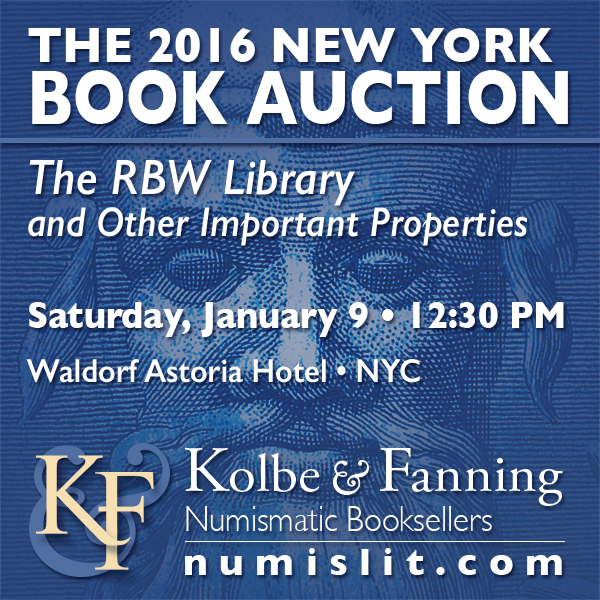
HANDLING COINAGE IN SAN FRANCISCO IN 1885
The following article is from San Francisco newspaper Daily Alta California in 1885. While this article focuses on gold coins (containing some rather interesting firsthand knowledge of handling them), it gives some historical perspective of the late Liberty Seated coin period on the Pacific Coast.
In reading this, one must remember that from 1853 through 1878 silver subsidiary coins (half-dollar, quarter, double-dime, dime and the silver half-dime) were only legal tender to the amount of $5.00. You could not take your excess amounts of silver coin to the Treasury or any other federal facility and exchange it for gold coin. So in California a few years before this article was written, silver subsidiary coin were apparently useless for the banks to take in, as they could not loan the silver coin out again in amounts over $5.00.
It is hard to imagine today but our Liberty Seated subsidiary coins were sold as a commodity, selling at a discount to face value of from 1 to 3 per cent based on supply and demand. The Commercial sections of the newspaper daily quoted the exchange rate, however, I have yet to find what minimum amounts were needed to receive that published rate and whether there were additional “per transaction” fees. Either would make small exchanges of silver for gold that much more expensive.
... twenties are the only coins that you can risk a count on by sizing one stack up with another. We never count but one stack here. Then all the balance is sized up, with the exception of the last stack, which is counted as a check on the first count.”
“Why can’t that be done with other coins?”
“They get too badly worn to make them come out evenly. In a stack of fives you will often find the difference of an entire piece, and even tens are so uneven as to make stacking them unreliable.”
The nimble-fingered young man then proceeded to illustrate his meaning with two trays of coin. One tray containing $20,000 in twenties, $400 to the stack, had the tops of the stacks as level as a billiard table and no one stack was higher or lower than its fellows to more than the thickness of a piece of cardboard. The other tray, filled with tens and fives, was so uneven as to bear the resemblance in places of a coin having been removed. This was not due to the minting, he explained, but to the wear of the coin in circulation. Twenties wear, too, of course, but the average man does not have a pocket full of twenties and they get less wear than their kindred of smaller denomination. “yes, twenties are the boss coin if you have much of it to handle,” he concluded, and the reporter thought so, too, as a depositor dumped $2,400 on the counter and the teller picked up $1,600 in one hand and $800 in the other, to convey it to the trays four feet behind.
“That is a pretty good load, isn’t it?”
“Oh no,” replied the teller cheerfully; “$4,000 is what we called a fair handful.”
“I could take another thousand by laying a couple of rolls on my wrist,” he went on, “but it is seldom necessary. If a deposit amounts to more than $5,000, I set an empty tray over on the counter and load it there.”
“I should think it would be easier to make two trips of it, where it is but a step from your counter to the trays. It certainly would take no more time than it would to stack it up the way you do on your hand.”
“My friend, I don’t want to make you feel bad, but I never turn my back to the counter for a single second if there is coin on it. No matter if you were the only person in sight, and you were my father, it would be just the same. Eternal vigilance is the price of twenty-dollar pieces in this business.”
I always had a great admiration for Bret Harte, until I read one of his yarns, where I was able to contradict him. One chapter in it was devoted to the robbery of the stage to Red Dog, and the driver was the hero. When the robbers brought him to a halt he fired the coach lamps at them, and then jumped on to one of the stage horses with the treasure-box, and after a race of six miles beat them into the nearest station. The treasure-box, so Bret Harte said, contained $50,000 in gold dust. Now if you can find a man that can ride a horse bareback over a mountain road, and hold a box weighing 168 pounds, and thus handicapped, beat two well-mounted men fully equipped, I’ll back him to whip Sullivan. I’m afraid that Bret didn’t figure the weight of coin down very fine when he made the horse and driver do such a trying feat.”
QUIZ QUIZ: Who can explain the (non-numismatic) reference to "Sullivan"? -Editor
Back issues of The E-Gobrecht can be found online here:
www.seateddimevarieties.com/LSCC.htm
For more information on the Liberty Seated Collectors Club, see:
www.lsccweb.org
THE RISE AND FALL OF THE FRANKLIN MINT
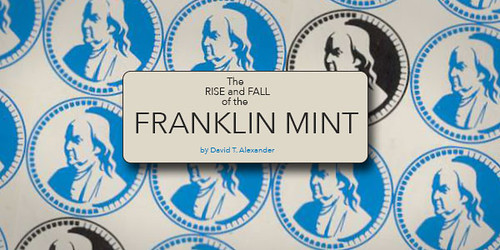
Early Days
The inside story of the Franklin Mint’s beginning is unknown to most collectors today, but is familiar to me because I observed the
Franklin Mint’s explosion onto the numismatic scene at first hand in 1966. My late brother, John L. Alexander (1938-1987) was a stock
broker instrumental in the underwriting of the mint’s first common stock listed on the National Stock Exchange (distant third of the “big
three:” New York, American and National exchanges).
John Alexander’s research in this dynamic young company interested his employers, the stock brokerage house of Hill, Darlington and Grimm, which was active in underwriting and promoting new stock issues.
FM was then only one department of a parent firm called General Numismatics Corporation (GNC), whose home town was Yeadon, Pa., not yet renamed Franklin Center. The story of the stock issue and of the beginning years of the Franklin Mint is basically the story of its founder, advertising specialties prodigy Joseph M. Segel (born 1931).
Segel was a remarkable example of the go-getting American entrepreneur, who launched GNC in 1964 with an investment of $21,000. His business experience was already extensive and uniformly successful. At the age of 13, he had launched a successful printing business before entering the prestigious Wharton School of Business administration in Philadelphia, PA.
Collectors who associate the name Franklin Mint with the cataracts of gleaming coins it struck and marketed for an array of governments or its many medal and ingot series are generally surprised to learn that most of its production in its founding year was base metal gaming tokens struck for 27 casinos, mostly located in Las Vegas and Reno, Nevada. Some of the research involved my driving all over Miami, FL, seeking examples of gaming tokens made by FM.
During 1964, silver prices began to soar, causing copper nickel-clad copper coins to come into production at the U.S. Mints and focusing avid interest on the millions of U.S. silver dollars needed to keep the casinos going “Ka-Ching!” that were vanishing overnight.
Segel watched as the clamoring public stormed the nation’s banks, eager to redeem their Silver Certificates for silver dollars from long-ignored Treasury stocks and later for silver granules from the national stockpile. Watching block-long lines form outside area banks, the young businessman was fascinated by the profits offered by coin collecting.
National Commemorative Society
Segel’s first step in numismatics was actually in the field of membership-based medal series, through his National Commemorative Society
(NCS). The first six NCS medals predated the creation of GNC and were struck elsewhere, but the society was Segel’s first venture in the
field of “limited edition’’ collectibles. It should be noted that these six issues were omitted from future FM catalogs.
A couple of early management decisions set the tone for Segel’s NCS and later membership medal series. All were struck in Sterling silver, .925 fine, which founder Segel appeared to believe was the highest fineness available. Makers of traditional large-diameter, high-relief medals, generally chose .999 fine silver for their creations.
NCS closed its subscriber list at only 5,249 members, issuing one 39-millimeter medal each month, which were unobtainable by frequently irritated non-members continuing to read about the series in the numismatic press. All were distinctly coin-like objects combining low relief and brilliant Proof surface.
Segel called all of these low-relief pieces “coin-medals.” The term was distinctly contrived but starkly necessary. In 1965 the vast majority of collectors in the U.S. were trained to focus on and collect coins and avoid medals at all costs. Segel resorted to this hybrid term to overcome a widely held prejudice. .
Gilroy Roberts
 Another major victory for Segel’s infant CNG was the hiring of U.S. Mint Chief Engraver Gilroy Roberts, creator of the Kennedy half dollar.
With remarkable courage, Roberts left a secure, if non-spectacular U.S. government civil service post to join a new and untried venture. Before his
death in 1992, Roberts became a wealthy man as Chairman of the Board of the Franklin Mint.
Another major victory for Segel’s infant CNG was the hiring of U.S. Mint Chief Engraver Gilroy Roberts, creator of the Kennedy half dollar.
With remarkable courage, Roberts left a secure, if non-spectacular U.S. government civil service post to join a new and untried venture. Before his
death in 1992, Roberts became a wealthy man as Chairman of the Board of the Franklin Mint.
His creative opportunities were unlimited in his new post, and in these early years great honor was paid to the Franklin Mint’s artistic staff. The name Gilroy Roberts “sold,” as in “Gilroy Roberts’ Birds,” and good use was made of it in merchandizing FM and its rapidly growing range of products.
Segel possessed limitless self confidence. Where others eased into competitive situations, testing the waters, he plunged right in. During the search for substitute metals for U.S. silver coinage, he was an active participant, distributing a cased three-piece set of dollar-size pieces called “Pattern Trial Proofs.” Designed by Roberts, these depicted historic Gardiner’s Island and its colony of fishing hawks or ospreys, located near the eastern tip of Long Island, N.Y.
Fantasy Coins and Real Inaugural Medals
Many collectors were disturbed by the Franklin Mint’s excursion into pure fantasy coinage. A 1965 set of purported coins of the “Sovereign
Order of Saint John of Jerusalem” attracted much debate since the authentic Sovereign Military Order of Malta (SMOM) in Rome already issued
symbolic coins that were widely collected.
SMOM is the actual military and charitable Order established in the Holy Land after the First Crusade in the 12th century. The Order was later based on the island of Rhodes and subsequently on Malta until 1798. Since the early 19th century it had its headquarters on the Bocca de Leone in Rome and is a recognized sovereign entity enjoying diplomatic relations with some 30 countries. The Franklin Mint’s group was based in remote Shickshinny, Pa., and had no relation to the historic order in Rome.
Segel’s relentless pursuit of the main chance was brilliantly exemplified in his successful bid for the contract to strike and distribute the 1973 Richard M. Nixon-Spiro T. Agnew Inaugural Medal. The late medal historian Neil MacNeil in his award-winning book, The President’s Medal described the Franklin Mint as “aggressive and almost startlingly active.” First donating $113,000 in Franklin Mint stock to the re-election committee, Segel closed in to clinch the medal deal.
Outgunning the staid and traditional Medallic Art Company, he had already prepared dies for five different portraits and struck bronze and silver medals from them to display to the overwhelmed Inaugural Committee. Medallic Art thought it could guarantee $750,000 in overall sale of medals and then then-popular collector plates. Segel guaranteed $1 million and promptly whipped out a bank check for that amount, payable immediately.
Not surprisingly, Franklin Mint and Gilroy Roberts produced the Nixon-Agnew Medal. It was marketed vigorously in both Proof and antique finishes in silver and bronze, bronze goldplate along with a dazzling Inaugural Plate with the same conjoined heads. Artistic criticism of its low relief and uninspired design went unheard as this medal was a dramatic financial success.
To read the complete article, see:
The Rise and Fall of the Franklin Mint
(www.coinweek.com/education/the-rise-and-fall-of-the-franklin-mint/)

STUDY REVIEWS MEDAL OF FREEDOM AWARDEES
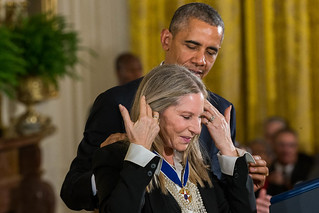 President Obama was having some fun with Barbra Streisand as he awarded her the Presidential Medal of Freedom at the White House last
month.
President Obama was having some fun with Barbra Streisand as he awarded her the Presidential Medal of Freedom at the White House last
month.
Reading her biography from prepared remarks, he came to the part that noted she had grown up in a middle-class Jewish family. Then he stopped and turned to her. “I didn’t know you were Jewish, Barbra,” he said with mock astonishment.
In a time of perpetual terrorism, war and crisis, Mr. Obama seemed to be enjoying a rare opportunity to deliver good news. Ms. Streisand was one of 17 people he honored that day with the nation’s highest civilian award. Indeed, Mr. Obama has come to enjoy his power to issue the medal so much that he has awarded more than any other president.
With November’s ceremony, Mr. Obama brought to 94 the number of medals he has awarded, passing Bill Clinton and Ronald Reagan, according to a new study. With a year still to go in office, it is a fair bet he will add more. And why not? It is one exercise of unilateral executive power that draws little or no complaint from Congress or the courts.
“This is a fun kind of busy right here,” Mr. Obama, perpetually busy, said as he opened last month’s ceremony.
Under the executive order that established it, the Presidential Medal of Freedom is bestowed at the president’s discretion to “any person who has made an especially meritorious contribution” to national security, world peace or “cultural or other significant public or private endeavors.”
The medal’s history dates to 1963, when John F. Kennedy inaugurated the honor. In the years after World War II, an earlier version, called simply the Medal of Freedom, was issued to those who had performed a service in war or for national security and was handed out not just by presidents but a variety of government officials. Kennedy wanted something broader, a way of marking contributions not just to security but to the arts, academia and public service — and reserved only for the president to bestow.
A study to be published soon in the New England Journal of Political Science examined the first half-century of the medal, from 1963 to 2013, and found that 27 percent of them went to figures from politics or public service; 15 percent to artists, actors and musicians; and 14 percent to leaders in academia or science. Nearly 10 percent of medals were awarded posthumously (like to Yogi Berra most recently), and nearly 7 percent went to foreigners (Nelson Mandela, Tony Blair).
At times, presidents have reached out across the aisle: Reagan awarded the medal to Eunice Kennedy Shriver, from the nation’s most prominent Democratic dynasty. Mr. Clinton gave one to Bob Dole as a consolation prize just two months after beating him in the 1996 election. George W. Bush honored Donna E. Shalala, the former health and services secretary. Mr. Obama selected his predecessor’s father, the first George Bush. But those are the exceptions, according to the study.
“Overwhelmingly, Republican presidents tend to bestow medals on Republican elected officials, and the same thing for the Democrats,” said Kyle C. Kopko, a professor at Elizabethtown College in Pennsylvania and one of the authors of the study. “Even though there might be some bipartisanship in recognizing public officials on the other side of the aisle, still by far they’re recognizing folks inside their own political party.”
To read the complete article, see:
Presidential
Medal of Freedom Says Something About Presenter, Too
(www.nytimes.com/2015/12/28/us/politics/presidential-medal-of-freedom-says-something-about-presenter-too.html)
FRENCH POLICE DOG TO RECEIVE DICKIN MEDAL
 Diesel, the now-famous police dog killed leading a police raid on a terrorist cell in Paris in November, will be honored with a medal for
gallantry.
Diesel, the now-famous police dog killed leading a police raid on a terrorist cell in Paris in November, will be honored with a medal for
gallantry.
The Belgian Malinois will be awarded the Dickin Medal, considered to be the highest animal honor in the world. Presented by the People’s Dispensary for Sick Animals (PDSA), the medal is considered the animal equivalent of the Victoria Cross, the highest military decoration awarded for valor "in the face of the enemy."
Diesel was part of the elite French Research, Assistance, Intervention and Deterrence unit. He was part of a siege on a suburban apartment targeting terrorists involved in the Nov. 13 Paris attacks. Diesel was sent into an apartment ahead of officers, where police say he was shot and killed by terrorists and likely saved the life of his handler.
“He did a tour of the first room, then he went into the second room and dashed forward. I think he’d found someone. Then I lost sight of him and the gunfire started again. His role was to open the way for the rest of us. He uses all his senses to detect if anyone is present and if he can get to them, to go and bite them. If not, he stands and barks to indicate where the person is hiding," Diesel's handler said.
“Following the tragic terrorist events in Paris last month, where many innocent people lost their lives, Diesel was instrumental in helping the French police locate and deal with the perpetrators. When news emerged of Diesel’s death there was a huge outpouring of grief," said PDSA Director General Jan McLoughlin.
"As guardians of the world’s most prestigious animal awards programme, we were inundated by messages from members of the public to recognise his heroism. The PDSA Dickin Medal recognises conspicuous devotion to duty in the theatre of conflict and Diesel is a truly deserving recipient. His gallant actions helped to protect human life in the face of imminent danger, and we are very proud to honour him in this way.”
Since the medal's introduction in 1943, it has been awarded to 30 dogs (including Diesel), 32 World War II messenger pigeons, three horses and one cat. The award is named after PDSA founder Maria Dickin.
The formal presentation of Diesel’s Dickin Medal will take place in 2016.
To read the complete article, see:
French police dog Diesel earns medal for bravery
(www.mnn.com/family/pets/stories/french-police-dog-earns-medal-bravery)
THE BOOK BAZARRE
SELECTIONS FROM STACKS BOWERS 2016 NYINC SALES
Lot 41216: MALTA. 30 Tari Siege Ingot, 1800
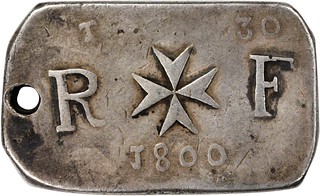
MALTA. 30 Tari Siege Ingot, 1800. VERY FINE. 22.10 X 36.03 mm; 29.02 gms. KM-350; De Mey & Poindessault-1041; Restelli & Sammut-pl. XC (plate coin); cf.VG-pg. 153 # 798/9. French mint master Joseph Lebrun. EXTREMELY RARE. Large Maltese cross flanked by "R" and "F" (Republique Francise) denomination above and date below; Reverse: Blank with Phrygian cap countermark.
During the occupation the native Maltese rebelled against the French and on 2 September drove them to the capital. On 29 December 1798 the British and the Russians signed a convention in St. Petersburg stating that upon the surrender of the French, Malta would be supplied a garrison consisting of British, Naples and Russian forces. After a brief stint off the island Russian admiral Fyodor Fyodorovich Ushakov was ordered to join the Russo-Turkish forces besieging the island of Corfu. In early 1799 the French were able to get several ships through the blockade to replenish the dwindling resources. Several requests were sent to the Russian admiral for his return to Malta, but were ignored as his fleet was in secere disrepair and he was awaiting orders from Czar Paul I. While corresponding with Nelson, Ushakov told the British Rear-admiral that with his ships and 2,000 men he would depart from Naples on 17 November, but never did. In fact Ushakov had planned on returning to the Black Sea instead of Malta, but ended up staying in Corfu until July 1800.
In the early summer of 1800 the British blockade continued to prevent French forces from resupplying the besieged Valletta. Nelson had sent several requests for the surrender of the city to which the French took great insult. By the end of the siege due to the lack of sufficient provisions more than 100 people were dying per day. On 4 September Vaubois dispatched an envoy to the British to discuss and sign the terms of surrender with Vaubois and Villeneuve. After the surrender of the French forces Malta became a British protectorate until it obtained independence in 1964.
The siege ingots of Malta as issued by the French in 1799-1800 mark the last coins actually struck in Malta, all of which are of the utmost rarity.
To read the complete lot description, see:
MALTA. 30 Tari Siege Ingot,
1800. VERY FINE. (www.stacksbowers.com/BrowseAuctions/LotDetail/
tabid/227/Lot/41216/AuctionID/6111/Default.aspx)
Lot 41328: PERU. South Peru. 8 Escudos, 1837-BA. Cuzco Mint
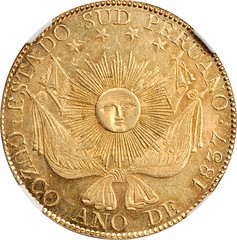
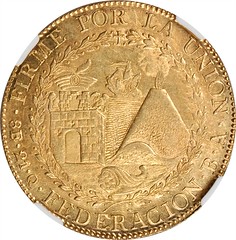
PERU. South Peru. 8 Escudos, 1837-BA. Cuzco Mint. NGC MS-62. Fr-91; KM-167. South Peru existed as a separate entity for only three years, and yet in this short time span some of this most beautiful coinage to ever be created in South America came to life. The compelling design elements of coinage from South Peru, combining much of the heritage of Peru into a single codified representation, have held great attraction for numismatists ever since these coins were first created. The coin offered here features the earlier ESTADO SUD PERUANO legend on the obverse along with four stars representing the four constituent departments of South Peru, which were comprised of Ayacucho, Cuzco, Arequipa and Puno. The reverse depicts features of South Peru including a volcano and a Inca fortress. Pristine examples of the issue are nearly non-existent, with virtually all examples suffering from laminations or other problems.
To read the complete lot description, see:
PERU. South Peru. 8 Escudos,
1837-BA. Cuzco Mint. (www.stacksbowers.com/BrowseAuctions/LotDetail/tabid/
227/AuctionID/6111/Lot/41328/Default.aspx)
Lot 41338: POLAND. Danzig. Peace of Westphalia Silver Medal

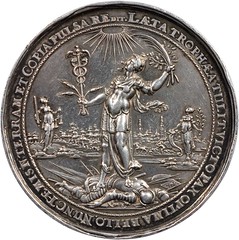
POLAND. Danzig. Peace of Westphalia Silver Medal, ND (1644). 60.6 mm; 66.1 gms. Pax-83; Maue-54. The war goddess Bellona fights with Pax, the goddess of peace, for peace on earth. A hand, at left, holds the globe. At the right a shield and lance lean against an olive tree. Inscription AMBIGUO PAX ET BELLUM LUCTAMINE CERTANT. PAX EUROPA VOVET. LAETA TROPHAEA FERAT! around. Reverse: Pax, the goddess of peace stands triumphant on fallen Mars, the god of war. In the left distance stands Themis, the goddess of divine order, with sword and scales in hand. In the right distance stands Abundantia, with her cornucopia and an olive branch. Legends LAETA TROPHAEA TULITVICTO PAX OPTIMA BELLO. NUNC THEMIS IN TERRAM ET COPIA PULSARE .DIT surrounds. By Sebastian Dadler, signed with a simple script D below Bellona and Pax. Undated version. This medal sometimes occurs dated 1644 near the sculptors signature, and also with the earlier date removed and 1648 stamped in its place as the treaty took several years to complete.
To read the complete lot description, see:
POLAND. Danzig. Peace of
Westphalia Silver Medal, ND (1644). (www.stacksbowers.com/BrowseAuctions/LotDetail/tabid/227/
AuctionID/6111/Lot/41338/Default.aspx)
Lot 41429: RUSSIA. Society of Fox-Terriers & Dachshunds Medal, 1886
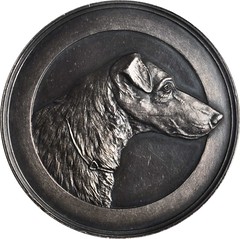
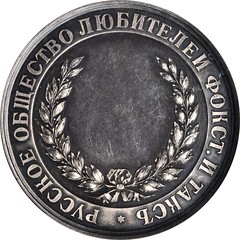
RUSSIA. Society of Fox-Terriers & Dachshunds Medal, 1886. NGC MS-62. 44 mm. Diakov-986.1. Plate medal from the Diakov catalog, and highly desirable as such. Struck in silver with light gray blue coloration and glossy semi reflective fields. The reverse remains uningraved. A few light marks in the open fields of the reverse, with the obverse canine portrait remarkably clean and quite impressive. We could not locate any record of previous transactions, at a minimum a very scarce medal, and presumably quite rare.
To read the complete lot description, see:
RUSSIA. Society of
Fox-Terriers & Dachshunds Medal, 1886 (www.stacksbowers.com/BrowseAuctions/LotDetail/
tabid/227/AuctionID/6111/Lot/41429/Default.aspx)
Lot 41453: 1914 Battle of Gangut Rouble
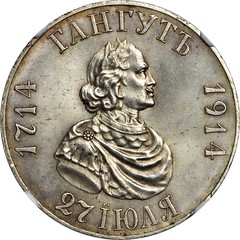
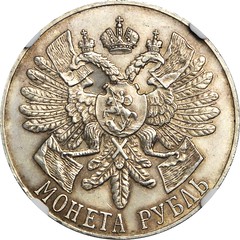
RUSSIA. Ruble, 1914-BC. NGC MS-63. Y-71; Bit-326. RARE. Struck to commemorate the 200th anniversary of the Battle of Gangut, a naval battle against Sweden that resulted in the first ever victory for the Russian navy during the Great Northern War. Historically speaking, the Russian navy didn't exist prior to the reign of Peter The Great, with the battle having vindicated The Tsar's policies to greatly expand it. The anniversary of the battle is still celebrated in Russia today. As a type, it would appear that most of the few surviving examples of this rare coin have been submitted multiple times at the grading services, rendering the population reports less than reliable when making an accurate assessment of the coin's availability.
To read the complete lot description, see:
RUSSIA. Ruble, 1914-BC.
(www.stacksbowers.com/BrowseAuctions/LotDetail/
tabid/227/AuctionID/6111/Lot/41453/Default.aspx)
Lot 40343: FRANCE. Duc de Berry Medal, 1815.

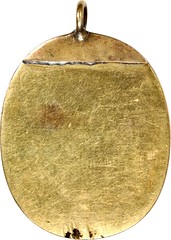
FRANCE. Duc de Berry Medal, 1815. Gilt Copper Royalist Support Badge, ND (c.1814). 44.3 x 36.8 mm; 58.4 gms. Laureate bust right of Charles Ferdinand d'Artois, the final Duc du Berri - Second Son of Charles X, assassinated by a Bonapartist in 1820. Around the bust appears the legend FOEDERATOS PARISIOS DUXIT. The reverse is blank, with a thin sheet of brass at the top to which the suspension loop is attached. Unsigned. Probably issued in 1814 during the period of time when he was Commander in Chief of the Parisian Army forces, but before he was forced to retreat from Paris during the Hundred Days War in 1815.
To read the complete lot description, see:
FRANCE. Duc de Berry Medal,
1815. (www.stacksbowers.com/BrowseAuctions/LotDetail/
tabid/227/AuctionID/6111/Lot/40343/Default.aspx)
Lot 50064: CANADA. Read, Stevenson & Co. 25 Cent
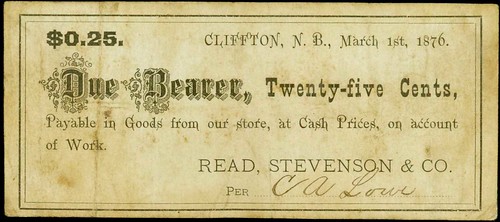
CANADA. Read, Stevenson & Co. 25 Cent, 1.3.1876. P-NL. PMG Very Fine 25. (NB-20-10-06) A scarce New Brunswick script note shown here with bold manuscript signature and just some staining to report.
To read the complete lot description, see:
CANADA. Read, Stevenson &
Co. 25 Cent, 1.3.1876. P-NL. (www.stacksbowers.com/BrowseAuctions/LotDetail/
tabid/227/AuctionID/6111/Lot/50064/Default.aspx)
Lot 50142: IRAN. Imperial Bank of Persia. 50 Tomans

IRAN. Imperial Bank of Persia. 50 Tomans, 12.11.1920. P-16. Very Fine. Payable at Isfahan only. This note caps off a terrific group of these 1924 issue notes we are offering. This ultra rare denomination is seen with quite pleasing color for the grade and nice overall appeal. A larger format BWC layout and seen with incredible color and intricate lathe work throughout.
To read the complete lot description, see:
IRAN. Imperial Bank of
Persia. 50 Tomans, 12.11.1920. P-16. (www.stacksbowers.com/BrowseAuctions/LotDetail/
tabid/227/AuctionID/6111/Lot/50142/Default.aspx)
MORE ON 'WHAT ARE TOKENS?'
Ron Thompson writes:
I’m not a lawyer but I decided to check the reference to the Constitution in the What are Tokens article. The preceding two sentences in the article say ” In the United States, tokens cannot have any indication nor appear to be issued by the United States. This may include not using the words “United States” and indicating a denomination.” The reference to Clause 1 is all about what states may or may not do. It is silent about individuals and private entities.
Clause 1 says “No state shall enter into any treaty, alliance, or confederation; grant letters of marque and reprisal; coin money; emit bills of credit; make anything but gold and silver coin a tender in payment of debts; pass any bill of attainder; ex post facto law, or law impairing the obligation of contracts, or grant any title of nobility.” There is no specific reference to not using the words United States or indicating a denomination. Over time and through various court cases I’m sure something like what the article said probably has evolved (haven’t most of us seen tokens with denominations on them?) but it is clearly the author’s opinion of the current situation. To reference the Constitution is misleading.
Duane H. Feisel writes:
A very shallow and essentially worthless article!
To read the earlier E-Sylum article, see:
WHAT ARE TOKENS? (www.coinbooks.org/esylum_v18n52a17.html)
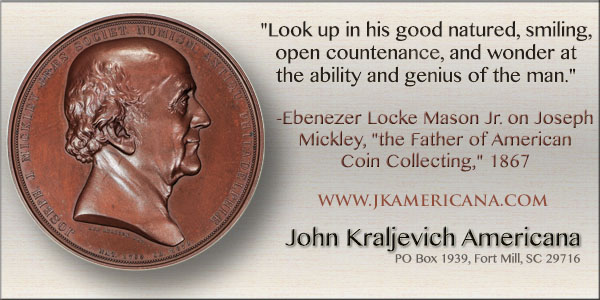
SMALL CHANGE USED MOSTLY BY ENSLAVED PEOPLES
Last week's excerpt from the American Numismatic Society's Pocket Change blog quoted researcher Katherine Smoak: "I am particularly interested in small change used mostly by enslaved peoples like black dogs and stampees."
Bob Leonard writes:
Am I missing something here? "Enslaved" people were paid after all, and required small change for their purchases?
Katherine Smoak writes:
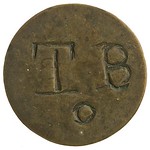 You're absolutely right, of course, that the experience of slavery over a time and varying places is quite different. In the Caribbean
in the 18th century, on many of the islands, enslaved people had provision grounds where they were expected, when not working on the plantation, to
grow their own food and sometimes raise small livestock to feed themselves. When and if they had surpluses, these were sold at weekly markets -- and
white and black inhabitants alike relied on the markets for much of their food.
You're absolutely right, of course, that the experience of slavery over a time and varying places is quite different. In the Caribbean
in the 18th century, on many of the islands, enslaved people had provision grounds where they were expected, when not working on the plantation, to
grow their own food and sometimes raise small livestock to feed themselves. When and if they had surpluses, these were sold at weekly markets -- and
white and black inhabitants alike relied on the markets for much of their food.
Overseers and planters would also occasionally give certain slaves small gifts of money for specific tasks or as some form of reward. These are all small transactions -- thus the need for small change. But enslaved people are not being paid for their daily labor -- this is just small amounts of money they earn from growing vegetables and raising chickens in their free time, on top of everything else they do.
To read the earlier E-Sylum article, see:
BLACK DOGS AND STAMPEES: THE RESEARCH OF KATHERINE SMOAK
(www.coinbooks.org/esylum_v18n52a19.html)
GOLD PLATES AND COINS UNEARTHED IN CHINA
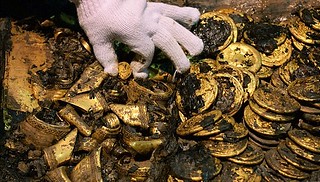 Gold plates are among the valuable items unearthed at the tomb of a Chinese emperor who died thousands of years ago.
Gold plates are among the valuable items unearthed at the tomb of a Chinese emperor who died thousands of years ago.
Archaeologists digging at the royal tombs of the Marquis of Haihun State of the Western Han Dynasty (206 BC-AD 24) uncovered large quantities of gold over the festive period.
The cemetery, which contains eight tombs and a chariot burial site, has been studied for five years and has produced Wuzhu bronze coins, jade and thousands of other gold, bronze and iron items.
According to China Daily, the royal tombs are the best preserved of the Western Han Dynasty ever found in the country.
It is thought the main tomb at the site in Jiangxi, an eastern Chinese province where archaeologists were digging at Christmas, belongs to Liu He, who was the grandson of Emperor Wu.
Other items found at the site include gold coins, hoof-shaped ingots, jade pendants, a distiller, horse-drawn vehicles, a board game and 2,000-year-old bronze lamps.
The goose-shaped lamps, which would have been filled with water, were designed to dispose of the smoke inside the tomb.
Since 2011, more than 10,000 pieces have been discovered at the tombs and 110 of these have gone on display at Jiangxi Provincial Museum in Nanchang. v
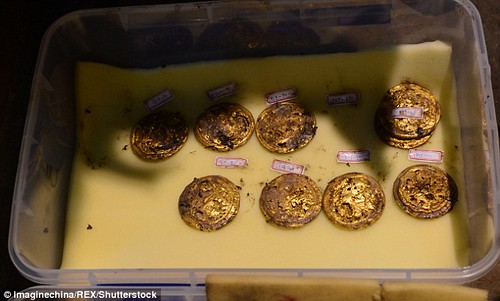
To read the complete article, see:
(www.dailymail.co.uk/news/article-3375474/Gold-plates-coins-valuable-haul-unearthed-archaeologists-2-000-year-old-royal-tombs-China.html)
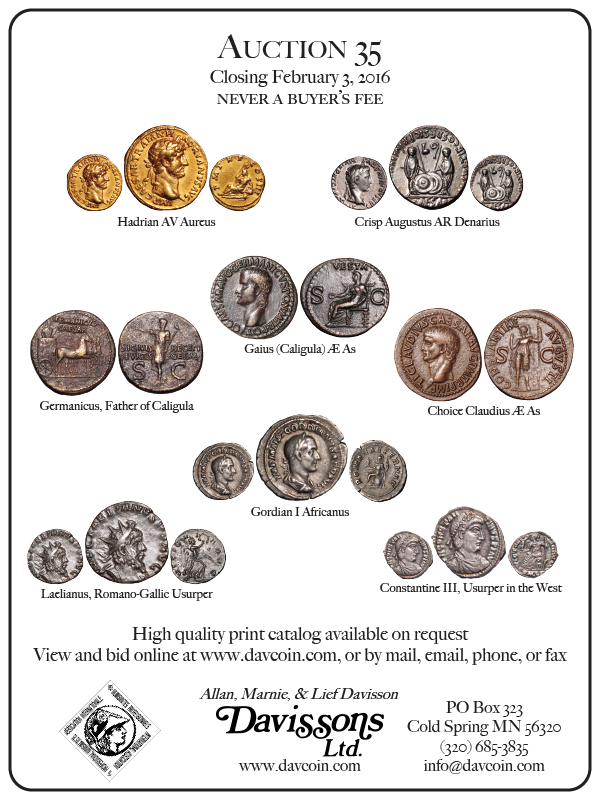
THE RARE NOTES OF LANAO PROVINCE, PHILIPPINES
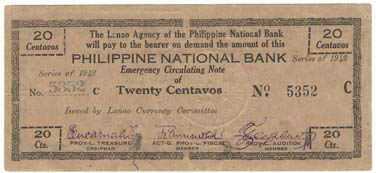
1942 Lanao Agency Emergency Circulating Note
Lanao was a province of the Philippines from 1914 until 1959 when it was divided into the provinces of Lanao del Norte and Lanao del Sur. It is located in the west central part of the sprawling island of Mindanao. The capital was Dansalan (presently known as Marawi City).
Late in January 1942, President Quezon authorized the formation of the Lanao Currency Committee. The amount to be printed was to be up to two-thirds of the province’s unencumbered bank deposits. The committee consisted of Provincial Treasurer Pedro Encarnacion as chairman, with Provincial Auditor Fortunato Alabagan and Provincial Fiscal Francisco A. Obach as members. Notes bear the three signatures, but the Provincial Fiscal was replaced for some reason and the title of Act-g. Provincial Fiscal appears instead.
Printing ended in March when the first Mindanao Emergency Currency Board began printing paper money for the entire Mindanao area. No information as to amount printed for the Lanao committee is available as the records were all destroyed during the war. Sometime later Encarnacion estimated that about 80,000 pesos in face value had been issued.
Denominations reported to have been printed are 20 centavos, 50 centavos, one, five, 10 and 20 pesos. This list was incomplete as it omits the two pesos; also, the five, 10 and 20 pesos are not verified. No examples of those values are represented in any known collection.
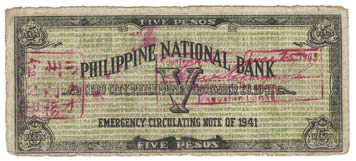
For more information about Numismatic News, see:
www.numismaticnews.net
1960 & 1963 GERMAN EMERGENCY BANK NOTES
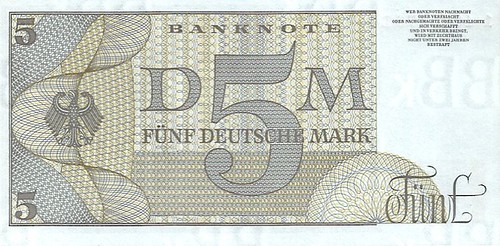
5 mark emergency issue, reverse
The 20th century numismatic history of Germany is extremely interesting and could provide material for dozens of articles on its coins, bank notes, and monetary policy. Two World Wars, hyperinflation, occupation by its former allies and enemies, and a division and subsequent unification have provided a fascinating picture of a country and its people. In this article we will take a look at just one item from that turbulent history: the 1960 & 1963 “Emergency” or reserve issues of West Germany.
In 1957, the Bank Deutscher Länder became the Deutsche Bundesbank, or German Central Bank, and preparations were made to issue a new series of notes that would replace both series in circulation at the time. Dated January 2, 1960, these notes would be placed in circulation at various dates during the first half of the 1960s, starting with the 20 mark in 1961. Later followed the 5, 10, 50, 100, 500, and 1,000 mark denominations.
The basic design of the issues included the portrait of a famous German on the right side of the front, based on original paintings, and various vignettes on the back, ranging from violins to castles. Virtually all denominations known were dated 1960, 1970, 1977, or 1980 (no 1,000 mark note dated 1970 was issued), but various individual varieties are known for each date. This series, known as the first Bundesbank issue, would continue to be printed until after German unification, and would not be replaced by a more modern Bundesbank issue in the early 1990s.
While these would be the only notes one would see in circulation in Germany, there were two other issues prepared. The first was prepared for West Germany outside of Berlin and is dated July 1, 1960. This series, of a different but similar design to the issued notes, contains 10, 20, 50, and 100 mark notes, designed by Max Bittrof. A second series, dated July 1, 1963, was printed for West Berlin and includes the 5, 10, 20, 50, and 100 mark notes, designed by Rudolf Gerhardt. Both series were printed as emergency issues in case the Cold War warranted a sudden currency reform. Their designs were similar to the issued notes (so that the public would accept them), but different enough that they could be quickly distinguished from the circulating notes that would have been declared defunct.
About 29 billion German marks of both of these emergency or reserve notes were printed in the 1960s and early 1970s. For the next 25 years, they would be stored in two underground bunkers, one in Frankfurt and the other one in the small town of Cochem, a quiet town of less than 5,000 located in the Rhineland. The reserve notes meant for Berlin (about 4 billion marks worth) were stored in Berlin at the Central Bank.
In the 1990s some 5 mark notes of the West Berlin series appeared on the numismatic market. The notes, all in pristine Uncirculated condition, appeared to have been stolen by somebody at the time they were supposed to have been destroyed. Very little if anything is known about the exact circumstances, but the “release” of these unissued notes was obviously not approved by the German Central Bank, which had managed to keep much of the notes secret for over 25 years (it was known that a reserve issue had been prepared in the 1960s, but exact circumstances were not known, and even the bunker in Cochem remained off limits for years after the end of the Cold War).
Initially only a few of these unissued notes appeared, but larger quantities started showing up around 2006. While this has suppressed the price of the notes on the market, the notes are not cheap, with an Uncirculated note carrying a catalog value of approximately $400. Unlike other stolen numismatic items, the German Central Bank has not demanded the notes back, although their legal ownership can be questioned. The notes are a very interesting and historical reminder of the Cold War.
To read the complete article, see:
1960 & 1963 German Emergency Bank Notes
(http://news.coinupdate.com/1960-1963-german-emergency-bank-notes/)
THE BOOK BAZARRE
BANKNOTE PRINTER DE LA RUE SAYS CASH IS STILL KING
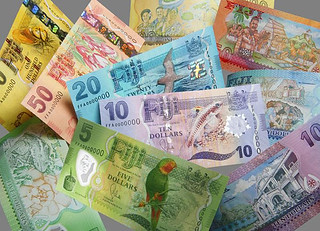 You might not know the company’s name, but you are definitely familiar with its biggest product – the £64bn of UK banknotes in
circulation.
You might not know the company’s name, but you are definitely familiar with its biggest product – the £64bn of UK banknotes in
circulation.
De La Rue is the company which produces the £5, £10, £20 and £50 notes for the Bank of England; and despite the rise of contactless payment and people’s willingness to pay by plastic, it has no worries about the future of printed money.
“Even though we’re using credit and debit cards more than ever, people still have cash in their wallet,” says chief executive Martin Sutherland, pictured left. “It’s convenient, it’s free at point of use, classless – not everyone has a bank account - and most of all, it’s reliable.
“Cash is the payment mechanism of last resort, it will still work when there’s a power cut or the card reader won’t scan.”
His confidence is backed up by data. Industry analyst PIRA says the banknote market in western Europe is growing at about 2.5pc a year, with much higher rates in regions with more developing nations.

De La Rue is the biggest commercial printer of banknotes in the world – in some countries print works are state-owned – and it’s also one of the most historic. The company has been printing banknotes for more than two centuries, while the paper business – De La Rue produces the paper used in notes and passports – is 300 years old. Looking further back, the company’s plant near Bath has been a mill for 1,000 years.
“There’s an amazing longevity and history to this business, so we must be doing something right,” says Sutherland, who was appointed to the top job in August 2014 with a brief to transform the underperforming company. Since then he’s launched a strategy that has involved concentrating banknote printing at three “centres of excellence” in Gateshead, Kenya and Sri Lanka, capable of producing 8bn notes a year. The company also runs the Bank of England’s plant in Debden, Essex.
Just over a year ago De La Rue had its 10-year deal with the Bank of England - believed to be the company’s biggest contract – renewed for another decade. Many believe such a high-profile client gives De La Rue a cachet that helps it win other business, though Sutherland is keen to flag up the company’s constant research and development work.
“We are generally seen as the leading designer of banknotes and passports but we have to be innovative about the security features we introduce because we are in an arms race with counterfeiters,” he says. “The longer a particular feature is in circulation, the more time they have to work out how it is done and how to reproduce it, so we have to be constantly introducing new ideas. We’re a counter-counterfeiting business.”
As well as “covert” security measures known only to central banks and De La Rue itself, there are more obvious features, such as the silver foil running through notes, holograms and ultraviolet inks.
Sutherland highlights a recent introduction called “active”, a visual affect where depending on how you view a note, it shows a different colour. “Think of it as an animation,” says the chief executive, who flatly refuses to even hint at what direction “covert” measures take in the future.
“Producing banknotes is a genuinely artistian process,” he says, adding that De La Rue’s designs will visit and photograph countries as well as meet the locals in the nations they produce money to “understand the essence” of those areas.

To read the complete article, see:
Cash
is king for the future, says UK banknote printer De La Rue
(www.telegraph.co.uk/finance/newsbysector/industry/12061880/Cash-is-king-for-the-future-says-UK-banknote-printer-De-La-Rue.html)
To read earlier E-Sylum articles, see:
BANK NOTE PRINTER DE LA RUE CELEBRATES ITS BICENTENNIAL
(www.coinbooks.org/esylum_v16n06a21.html)
NEW BOOK: THE HIGHEST PERFECTION: A HISTORY OF DE LA RUE
(www.coinbooks.org/esylum_v16n07a05.html)
A VISIT TO BANKNOTE PRINTER DE LA RUE
(www.coinbooks.org/esylum_v17n41a24.html)
CELEBRITY COLLECTOR: ACTOR MACKENZIE CROOK
 Mackenzie Crook is turning into his dad.
Mackenzie Crook is turning into his dad.
The 'Pirates of the Caribbean' actor has confessed he's becoming more and more like his old man as he gets older, and is now interested in activities he thought were boring when he was a young lad.
Speaking about the inspiration behind his TV series 'Detectorists' - which follows two members of a metal detecting club - Mackenzie exclusively told BANG Showbiz: "I've always had collections and my dad's always had collections.
"My dad was a coin collector and he tried to get me into it when I was a kid but I just thought it was the most boring thing ever and then a few years ago something happened, something in my brain switched and I suddenly realised and now I find myself turning into my dad and I'm collecting coins myself."
The 44-year-old star went on to admit that he doesn't mind becoming more like his dad but that he tries to keep his coin collecting a secret.
He added: "I quite like it actually. I've made my peace with it, but I still won't often tell people I'm a coin collector. Maybe it's just something private."
To read the complete article, see:
Mackenzie Crook has his dad's hobbies
(www.thespec.com/whatson-story/6214863-mackenzie-crook-has-his-dad-s-hobbies/)

THE AUSTRIAN NATIONAL LIBRARY
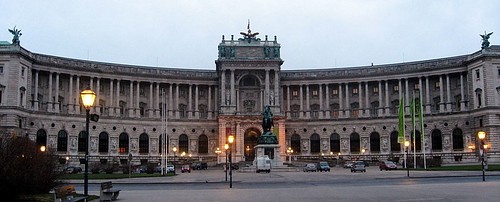
The Österreichische Nationalbibliothek (Austrian National Library) is a breathtaking baroque masterpiece, finished in 1726.
Formerly the court library to the Hapsburgs, it is one of the world's major libraries, with an extraordinary collection that dates back to the 14th century. The current collection contains around 2.5 million books.
Visitors can visit many special collections in addition to the main halls, which include prints, maps, papyri, portraits, music, and theater. But the magnificent library itself is the focal point here. Among the exhibitions are two exquisite Venetian baroque globes — one for the Earth and one for the sky, each with a diameter of more than one meter.
Keep your eye out for library employees slipping through concealed passages hidden behind certain bookcases.
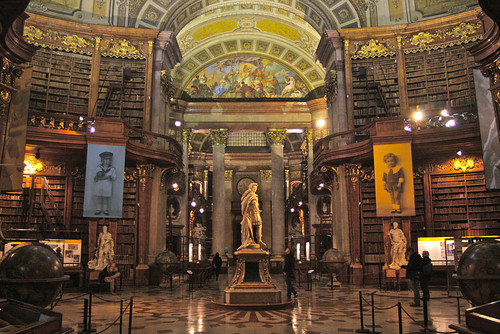
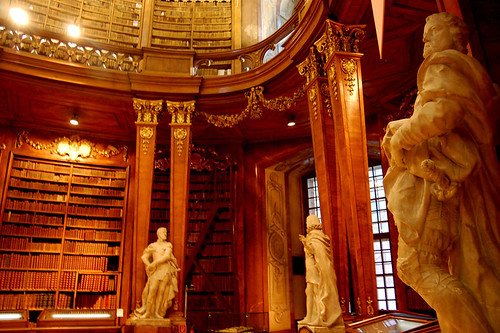
To read the complete article, see:
ÖSTERREICHISCHE NATIONALBIBLIOTHEK - AUSTRIAN NATIONAL
LIBRARY (www.atlasobscura.com/places/osterreichische-nationalbibliothek)
THE SOLOMON ISLANDS’ PIZZA COIN
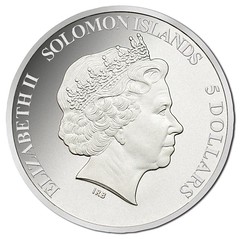
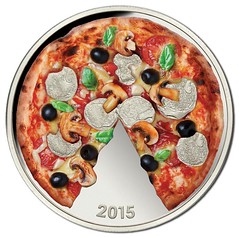
The latest issue in the scratch-’n-sniff range is a Solomon Islands’ pizza $5. The 38.61 mm, 20 g .999 fine silver coin arrives packaged in a pizza box. Inside a gentle rub of the $5 reverse yields the delightful aroma of freshly melted mozzarella plus lightly seared salami all modulated by a subtle herbal bouquet.
The colorized coin has a mintage of just 1,500. If your local dealer cannot supply one can be sourced from Downies: info@downies.com
For more information, see:
2015 $5
Pizza Scented Silver BU
(www.downies.com/World-Coins-and-Banknotes/Solomon-Islands/2015-Pizza-Scented-Silver-Coin/6666/productview.aspx)
THE BOOK BAZARRE
TEEN FIRST AGAIN AT ROYAL AUSTRALIAN MINT IN 2016
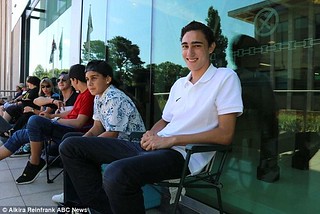 A 16-year-old boy has camped out for a week, even sleeping rough on Christmas Day, to ensure he was first to line to collect the first ever
coin of 2016.
A 16-year-old boy has camped out for a week, even sleeping rough on Christmas Day, to ensure he was first to line to collect the first ever
coin of 2016.
For the fourth year in a row, Sydney coin enthusiast Harley Russo has had the honour of striking the first coin of the year after camping outside the Royal Australian Mint in Canberra.
The teen is always so determined to collect the first coin of the year he has even refused an offer of $3500 to give up his prime position in the queue, according to ABC.
It is a strategic move from the young man, as the first coin of the year is a valuable asset and Harley hopes one day his coins will be worth enough he can place a deposit on a house, according to the Canberra Times.
However, it was a close call this year and Harley almost missed the prized first coin. He claims another eager coin fan arrived just 20 minutes after the teen took his place outside the Mint on Christmas Day - narrowly missing out on first place in the queue.
Harley is a third generation coin collector has been an avid coin fan since he first saw his grandfather’s collection when he was around nine years old.
Australia is the first country to press the new coin of the year due to the time zone.
To read the complete article, see:
Teenager sleeps rough on Christmas Day and camps out all week at Royal Australian Mint just so he can collect the first coin of the year -
for the fourth year in a row
(www.dailymail.co.uk/news/article-3381061/Teenager-sleeps-rough-Christmas-Day-camps-week-Royal-Australian-Mint-just-collect-coin-year-fourth-year-row.html)
To read the Canberra Times article, see:
Harley Russo camps outside Mint for a week and knocks back offers for first coin
(www.canberratimes.com.au/act-news/harley-russo-camps-outside-mint-for-a-week-and-knocks-back-offers-for-first-coin-20151230-glwo35.html)
To read the earlier E-Sylum articles, see:
TEENAGER CAMPS OUT TO BE FIRST AT ROYAL AUSTRALIAN MINT SALE
(www.coinbooks.org/esylum_v16n01a27.html)
TEENAGER FIRST AGAIN AT ROYAL AUSTRALIAN MINT IN 2014
(www.coinbooks.org/esylum_v17n01a33.html)
NEW YEARS MEDALS
As the dawning of a new year has long been an occasion for celebration, but at least in numismatic terms, it seems to be the Germans who party the hardest. During the late nineteenth century, striking small medals and giving them away as one might send cards to friends and family was a common practice. But this new year’s numismatic practice extended all the way back into the eighteenth century as well.

This commemorative medal was struck to mark the beginning of 1718. The obverse apes Roman imagery in depicting Charles VI as a conquering hero and celebrates the Holy Roman Empire’s defeat of the Ottoman Empire in the Austro-Turkish War. The expression for best wishes in the new year in the exergue is rather tangential here, but the rise of specialist firms like Ludwig Christoph Lauer in the nineteenth century democratized the practice of medal-making.
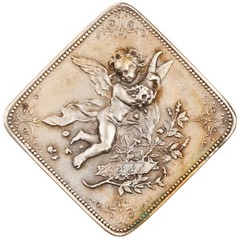

This pretty medalet depicting angels with the inscription VIEL GLUCK ZUM NEUEN JAHR (good luck for the new year) is a nice example of the sort that were being struck and given away around this time. This particular one marks the beginning of 1890.
The most common form that these new year’s trinkets took in Austria and German was in medals that resembled business cards. The example below is a particularly rich one.
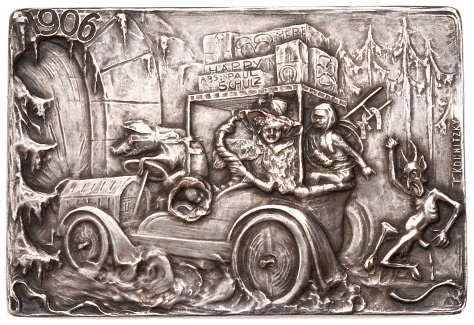
The medal is the work of Franz Kounitzky, and you can see on the top of the car that the “sender” of this card (as indicated by the “ABS”) was Paul Schulz. It features an incredible ensemble of good luck charms for the new year of 1906: an automobile with a pig driving, a female figure holding a large cornucopia and a chimney sweep holding ladder with horseshoes sit in the back; there is a four-leafed clover on the luggage on top of the car; behind it is a devil with cut off tail raising its fist in anger (presumably the pig has just run him over?). Whatever the case, Frohes Neues Jahr!
To read the complete article, see:
FROHES NEUES JAHR | HAPPY NEW YEAR
(www.anspocketchange.org/frohes-neues-jahr-happy-new-year/)
FEATURED WEB SITE: CONDER TOKEN COLLECTOR'S CLUB
This week's Featured Web Site is the Conder Token Collector's Club.The Conder Token Collector's Club welcomes all numismatists with an interest in the British Provincial tokens of the late 18th Century, otherwise known as "Conder tokens," after James Conder, whose name appears on some of the tokens. Officially, "Conder tokens" may include British and Irish tokens from 1787 to 1804.

www.ctcc.info

